TOP OF THE CLASS
The recent Holstein Australia National Judging School held at Victor Harbour in South Australia, has been deemed a great success. More, PAGE 4




Healthier cows are proven to stay in your herd for longer. And thanks to CowScout heat and health collars, you can act faster than ever before if there are potential health problems.

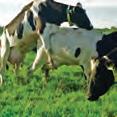


Calf rearing feature. Pages 29-33 JUNE, 2023 ISSUE 152 // www.dairynewsaustralia.com.au BORN TO CHAT ABOUT DAIRY PAGE 8
ALL ABOARD FOR WINTER FAIR PAGE 6 STAY IN CONTROL THIS SEASON Stay in control with CowScout collars: GEA.com/australia | 03 8877 99999
Detect metabolic disorders early Identify non-cyclers and slipped cows Improve in-calf rates Work with user-friendly software
PROBIOTIC BOOST GEL
ProfeSTART PROBIOTIC GEL is a micro-encapsulated, multi-strain probiotic, containing live (viable) naturally occurring microorganisms; fed to calves, dairy cows and beef cattle during times of stress.

Guaranteed analysis: 3 Billion CFU/g.
Application – convenient and easy-to-use digestive aid
Performance – improve health and recovery during times of disease, stress, ill-thrift & gastric upset
Price – exceptional value for ease of application
The ProviCo Difference
Natural formulation based on global research, development and innovation
Tried, tested and proven worldwide
Unsurpassed product quality, performance and on-farm infant animal rearing support Endorsed by leading professionals and calf specialists
Available from leading retail outlets nation wide
ENERGY BOOST PASTE
Newborn survival is dependent on their ability to stand and suckle first colostrum which is rich in energy, protein and disease fighting proteins (lgG). ‘At-Risk’ newborns that are unable to mobilise their energy reserves will benefit from ProviCo ENERGY BOOST so they can stand up, suckle and feed strongly.
Global demand stays steady











 BY ISABEL DANDO
BY ISABEL DANDO

DEMAND FOR dairy around the world continues to be driven by affordability, shaping both domestic purchasing behaviours, and importing activity.







Despite this, we continue to see milk production and exportable surpluses grow across the United States, Europe and New Zealand.
With quiet demand placing pressure on commodity prices, and therefore farm gate milk prices offered within these exporting regions, the key driver that is common between all is favourable weather.




For the US, mild winter temperatures have supported many dairying regions during the past six months in addition to continuing production growth driven by a growing national herd and higher milk yields per cow.
Supportive conditions through to spring in most producing regions have kept milk production tracking along steadily despite expectations of typical seasonal declines.

With consecutive production growth continuing into March, recording an overall increase of 0.6 per cent year-on-year.




Almost all major producing states continue to record positive monthly production figures, offsetting the declines faced in the largest, California, where many farmers are dealing with flooding impacts.
From an exporting perspective, suppressed domestic demand has further contributed to

increased exportable supply.



















In a similar manner, many regions across Europe experienced milder-than-usual conditions over their winter, allowing for pasture growth and improved feed availability to support cows and boost milk flows during a time that it typically dips.
European milk production began to show growth from October last year, this since having continued through the spring flush, with another 0.8 per cent increase across February.
In the United Kingdom, this positive production response from the end of last year, was helped in part by the incentive of high farm gate milk prices.
Although favourable weather conditions throughout some regions have continued to support production increases, other areas continue to battle now falling farm gate milk prices and other incentives or restrictions to reduce emissions or stop producing all together.

Milk production has also grown in New Zealand in recent months, up another one per cent in March.


Many dairying regions have enjoyed a wet end to summer, with strong pasture growth and feed availability being the key drivers of this consecutive monthly growth.
According to analysts, pasture growth conditions are currently better than recent seasons and historical averages and are likely to support production through to the end of the season.

However, despite this, there are still expectations that production will end the full 202223 season down about 0.7 per cent.

Global demand, while it has softened, remains relatively steady, with both importers and consumers bound by affordability pressures.
China’s relative lack of demand is a key driver, with growing local milk production, increasing powder stockpiles and reduced consumer activity all contributing.
Globally, this dynamic has played out over the past few months, and with buyer sentiment and affordability still at the wheel for many, is expected to remain for some time. While milk production continues to grow in the US, Europe, and New Zealand, and both domestic and international demand remain stagnant, this increased exportable supply is expected to lean on commodity prices for some time yet.
NEWS 4–28 CALF REARING 29–33 ANIMAL HEALTH 34 MACHINERY & PRODUCTS 35–39 System pays its way PG.13
PG.17 To drench or not to drench? PG.34
Proof is in the pasture
// 3 DAIRY NEWS AUSTRALIA JUNE 2023 NEWS UPGRADE YOUR SHED HYGIENE? IS I T T I M E TO delaval.com Talk to the Upgrade Specialists 1800 817 199 Our teat sprays and detergents help ensure high quality milk to safeguard your profitability.
Although favourable weather conditions throughout some regions have continued to support production increases, other areas continue to battle now falling farm gate milk prices and other incentives or restrictions to reduce emissions or stop producing all together.
Judging school’s top class
BY SOPHIE BALDWIN
THE HOSTING of the Holstein Australia National Judging School at Victor Harbour in South Australia recently has been deemed a success by HA breed development and conformation committee president and school co-ordinator Gino Pacitti.

Gino said 19 enthusiastic participants from Victoria and South Australia took part in the event which resulted in Casey Trealor (SA), Courtney Afford (SA) and Georgia Sieben (Victoria) qualifying for the National Judges Panel.
The panel includes judges from every state in the country.
The event was originally to be held in November but was postponed to March this year.
“It was great to see three of the participants make it through. Some others were pretty close and if they hone their skills in the near future, they will join Casey, Courtney and Georgia,” Gino said.
There is a fair bit of organising that goes into
the event which includes cows to judge and farms to visit.
Three South Australian Master Breeder herds — Misty Brae Holsteins, Rockwella Farm and Windy Vale put their hands up so participants could work with their animals as part of the program.
“It really is a team effort to get a course like this up and running and the South Australian sub-branch were wonderful and put on a really great event,” Gino said.
Day one of the three-day event focused on cow structure and the ethics of judging, while day two saw participants working with groups of cows followed by a discussion led by over-judges on the differences in on-farm competition and show-ring judging.
The over-judges were Jenny Grey from The Pines, NSW, Vaughn Johnston, Ewen Pine, Rob Walmsely, Robsvue and David Peglar, Sleepy Hollow, all from South Australia.
The final day was show day, with an early start followed by the opportunity for participants to present to the over-judges.
“It is a really diverse course which not only focuses on cow structure and conformation

CASEY FINDS A PERFECT BALANCE
Casey Treloar’s real job might be working as a reporter, presenter and producer for 7News, but she has found a way to fit her love of dairy cows into her work/life balance and she couldn’t be happier.

Not only is Casey still breeding cows and loving every minute of it, she recently participated in Holstein Australia’s National Judging Day in Victor Harbor in her home state, where she joined fellow participants Courtney Afford and Georgia Sieben qualifying for the National Judges Panel.
“It has been such a privilege to be able balance the enjoyment of both my career and my hobby, but that is one of the best things about the dairy industry,” Casey said.
“I was going to attend the school five or six years ago but this time around the event was held just five minutes from my Mum and Dad’s and the opportunity was too great to miss.”
Casey’s love of cows, showing and judging, goes back many years.
Sales Representative, NE Vic & Southern NSW
Kate has both practical and technical experience working within the animal health and production sector, servicing both dairy and beef livestock systems.
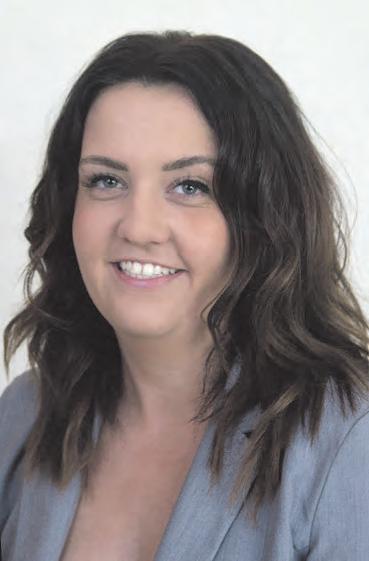
MEET KATE HENNE
Her passion for showing began when she started competing in junior judging competitions where she often placed in the top three.
The turning point in understanding the fundamentals of judging came after completing a dairy youth scholarship when she was 18 and began judging at some of the smaller country shows during the past decade.
Making the National Judges Panel will allow her to step up to the next level.
“It has always been my dream to make it to the panel at a royal show one day and do some top level judging,” she said.
“It is always an honour to judge at any show of course, but I am looking forward to one day reaching some high calibre shows.”
Casey said the three-day experience at the judging school was intense but extremely worthwhile.
“We had some fascinating lectures learning about the history of the shape of cows and how breeding has changed them over the years; how cows move
Casey Treloar’s real job might be working for 7News, but she has found a way to fit her love of dairy cows into her work/life balance and she couldn’t be happier.
4 // DAIRY NEWS AUSTRALIA JUNE 2023 NEWS
Holstein Australia National Judging School participants on the last day of the event.
KEENAN Machine Sales & Feed Additive Support
Contact Kate today Phone 0418 173 707 Kate.Henne@alltech.com
but also other things a judge needs to be successful including public speaking, microphone technique and judging photos; we really want our future judges to have good all-round skills,” Gino said.
He also said participants couldn’t have had a better team of experienced judges.
“There are many, many hours and years of combined experience from Jenny, Vaughn, Rob and David and the participants certainly made the most of it,” he said.
This year the event was opened up to other



and blend together, it was amazing,” Casey said.
She also learnt how to break down a cow from a photo.
“Technology is going to play a huge role in the future of dairy and learning how to correctly look at a cow in a photographic competition is essential.”

The opportunity to learn from a group of judges with years of experience was also extremely beneficial.
“The wealth of knowledge the over-judges had, their guidance and the way they challenged us to learn and understand how placings work was unbelievable — they have so much knowledge on showmanship and why it is important to be a good, ethical judge,” Casey said.
Casey said to join the judging panel with two other women was exciting.
“It’s great to see women acknowledged and it is great for the industry too, there are just so many opportunities if you are willing to put yourself out there,” she said.






When Casey’s family left the dairy industry she hung on to a few her
breed societies and with the majority of participants below 25, the future of the judging in Australia certainly looks positive.
“It was great to see people from other breeds come along and we have a definite need for more qualified judges within the industry,” Gino said.
“We were all suitability impressed by all the participants which augers well for the future longevity of the industry and the event.”
Gino said the event came at a time when the South Australian dairy industry was in a


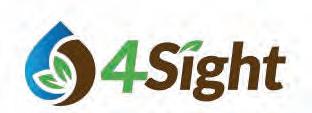

favourite cows, now she has a expanded her team to include 15 show cows across three breeds including Holsteins, Ayrshire and Jersey.
“I get a real kick out of showing my own animals along with judging,” she said.

“I really thought I would grow out of this one day, but here I am still breeding some amazing cows, and loving the dairy industry as much as I did years ago.”

Casey said it was heartening to participate in a recent calf show in South Australia which had one of the biggest days in the history of the event.

“There were over 70 animals in the show which is great for the future of the industry,” she said.




Casey considers herself lucky to have a job outside the dairy industry but still show cows under her own right.

“There are still opportunities for you in the dairy industry even if you don’t own your own farm, and that is one of the best things about the dairy industry, you can always be involved and it really is such a great industry,” Casey said.

steady phase after the rapid decline of the past 15 years.









“The industry seems to have bottomed out and many farmers are actually in an expansion phase, many are enthusiastic about their future and more importantly confident which is great for the industry,” he said.








“Dairying is such a great industry and an event like this provides participants with the opportunity to foster relationships and network not just here in Australia, but right around the world — the exposure can be worldwide.”


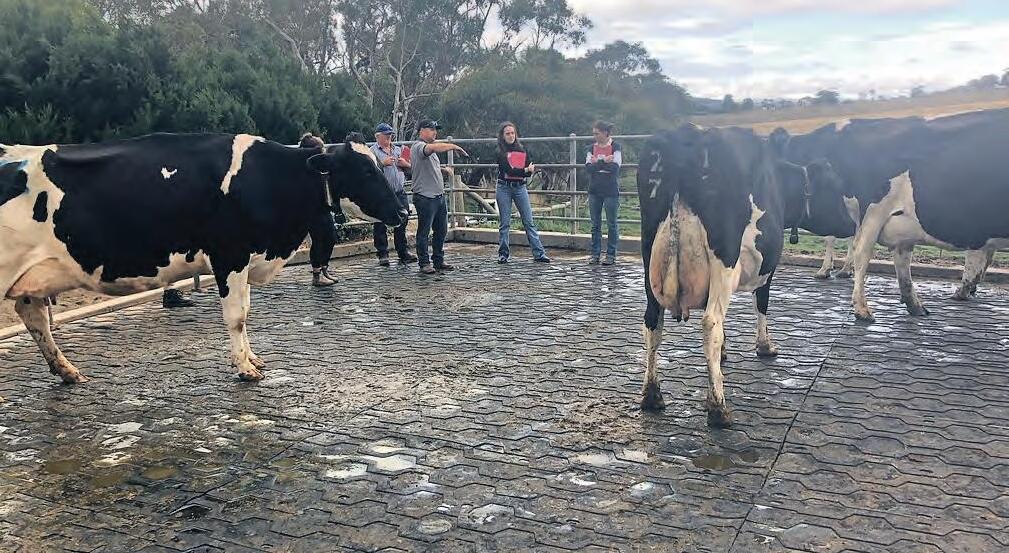
BALANCE
Casey still enjoys showing and has a expanded her team to include 15 show cows across three breeds including Holsteins, Ayrshire and Jersey.
Participants going through their paces.
The judging school’s judges Vaughn Johnson, Jenny Grey, Rob Walmsley and David Peglar.
// 5 DAIRY NEWS AUSTRALIA JUNE 2023 NEWS Did you know, your dairy farm can be far more profitable just by having BETTER SOIL? The RESTORE™ Soil Health Program brought to you by: Find out how much with this FREE estimator Proven results, grounded in science:
Increase productivity and
Reduce input costs. LESS WATER* 39% 23% LESS NITROGEN* 51% MORE PASTURE* *Based on large-scale case studies.
The future is bright for dairying, according to school co-ordinator Gino Pacitti.
●
●
All aboard for winter fair
BY SOPHIE BALDWIN
AS THE cold weather fast approaches, dairy farmers across the country will be getting their heifers and cows ready for the ninth annual National Herd Development Victorian Winter Fair from June 27 to 29.

Winter fair organiser Clare Modra said the organising team was expecting another great event come the end of June.
“It is too early to start talking numbers but cheap water and good milk prices mean there is a fair bit of optimism around in the industry this year and we think that will be reflected in numbers,” Clare said.
As always, the well attended junior judging day will kick off on Tuesday, followed by the heifers on Wednesday and the in-milk classes on Thursday.
Gorbro Holsteins from Cohuna will be trying their hardest to take out champion cow for the fourth time in a row, principle Glen Gordon
said they were currently preparing one of their biggest teams ever for the fair.
“We currently have 12 in-milk cows, six to seven heifers and a big spread across the age group — none of these animals have ever won before so we are looking forward to seeing what the show will bring,” he said.
Glen said they were taking a few more heifers than they normally would this year.
“The winter fair provides an opportunity to prepare a different group of cows to what we have for International Dairy Week,” he said.
“With IDW we have to worry about the heat and with the fair it’s the cold, but either way, both events have their challenges and provide a great opportunity and we are certainly looking forward to this year’s event.”
In a first for the fair, the principle judge this year is Mandi Bue from Wisconsin along with associate judge Ricky Nelson from Queensland.
Clare said this was the first time the winter fair had recruited an overseas female judge and Mandi certainly comes with high credentials, officiating numerous cattle shows across the United States including Holstein judge at the Hoard’s Dairyman Judging Contest and associate judge at the International Ayrshire Show at World Dairy Expo.
Mandi along with her husband Eddie manage Milsource Genetics — an elite Holstein, red and white, and Jersey herd, producing numerous All-American nominees.
The couple has also partnered on several successful show animals, including the 2019 International Holstein Show Intermediate Champion, Floydholm MC Emoji-ET.
Clare said this year would also see the return of the Elders sale to be held on Wednesday night after a few years break due to COVID-19.
The Power of Women in dairy World Dairy Expo scholarship winner will be announced at a special afternoon tea held after judging on Wednesday.
The fair is held in the school holidays to ensure youth participation and remains the
only major show in Australia that caters for autumn calved cows.
Clare said the committee remained grateful to major sponsors National Herd Development, Elders who sponsor the red show and Bega who sponsor the youth show.
“The winter fair is always well supported by farmers from across the country and we can’t wait to see what this year brings,” Clare said.
APPLICATIONS OPEN FOR DAIRY AUSTRALIA BOARD POSITIONS
The Dairy Australia board is seeking directors to fill upcoming vacancies and to be appointed at the November 2023 annual general meeting.
Two of the four vacant positions are for farmers with milk producer skills, one is for a director with agribusiness, innovation and adoption skills, and another for a director with dairy supply chain and product promotion skills.
Farmers and those with the relevant skills and experience are encouraged to stand for one of the board director positions and to play a role in the governance and strategic direction of Dairy Australia.
Dairy Australia aims to provide services that benefit and advance dairy farm businesses and the industry.

These services deliver value by enhancing farm business management, supporting employment and people development, driving herd and feed innovation, managing climate and environment, promoting Australian dairy and the commitment to
sustainability, supporting international dairy markets, contributing to policy development, and responding to critical issues and events.
Dairy Australia’s board comprises eight non-executive directors and the managing director.
At least four directors must be farmers or those with milk producer skills.
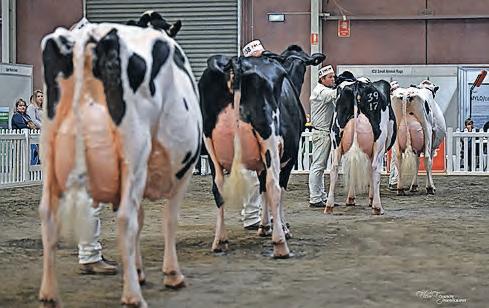
A board skills matrix specifies the mix of skills required by directors and is aligned with Dairy Australia’s funding agreement with the Commonwealth Government.
Farmer candidates interested in applying should refer to the director elections section of the Dairy Australia website and submit their applications by 5pm on June 16, 2023.
Those interested in the agribusiness, innovation and adoption and dairy supply chain and product promotion director roles should contact Rimfire Resources, a specialist recruiter, on https://www.rimfireresources.com.au/
Farmers and those with the relevant skills and experience are encouraged to stand for one of the Dairy Australia board director positions.
Letters to the editor on topical issues are also welcome.
Letters should be concise and carry the name and town address of the author, as well as a contact phone number, not for publication.
Dairy News Australia is published by Shepparton Newspapers Pty Ltd. All editorial copy and photographs are subject to copyright and may not be reproduced without prior written permission of the publisher. Opinions or comments expressed within this publication are not necessarily those of the staff, management or directors of Shepparton Newspapers Pty Ltd. WWW.DAIRYNEWSAUSTRALIA.COM.AU
Hyde 0408 558 938 max.hyde@dairynewsaustralia.com.au
Advertising Max
(03) 5820 3254 editor@dairynewsaustralia.com.au Regional editor news@dairynewsaustralia.com.au
Shepparton Newspapers Pty Ltd Printed by Newsprinters Pty Ltd Head Office 7940 Goulburn Valley Highway Shepparton, VIC 3630 Phone (03) 5831 2312 Postal address PO Box 204 Shepparton, Victoria 3632 Australia
News Australia welcomes contributions from stakeholders in the dairy industry, and
Editor Fiona Lloyd
Publisher
Dairy
particularly from organisations wishing to advance the industry.
Contributions and photos can be sent to: editor@dairynewsaustralia.com.au
The National Herd Development Victorian Winter Fair is always held in school holidays to ensure youth participation and remains the only major show in Australia that caters for autumn calved cows.
6 // DAIRY NEWS AUSTRALIA JUNE 2023 NEWS
The ninth annual National Herd Development Victorian Winter Fair will be held on June 27 to 29 at the Bendigo Exhibition Centre.
EARLY DETECTION, MORE CONTROL

















Want to monitor your herd closely, even when you’re not on-farm? Treat cows before they actually get sick? No problem. Thousands of farmers across the globe have chosen CowManager to do just that. The system alerts you before a cow even shows signs of clinical illness, so you can run you business proactively, rather than reactively. www.cowmanager.com



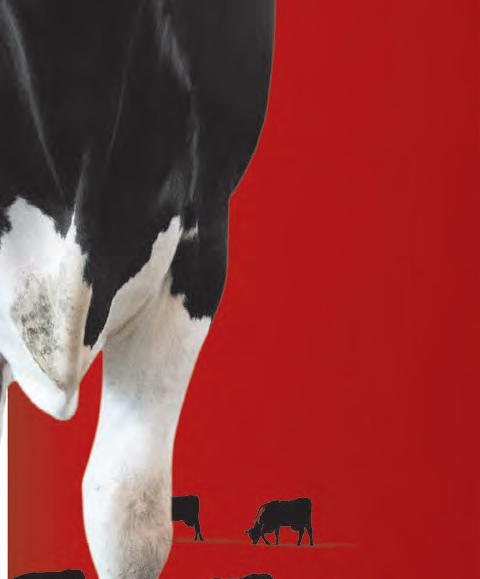
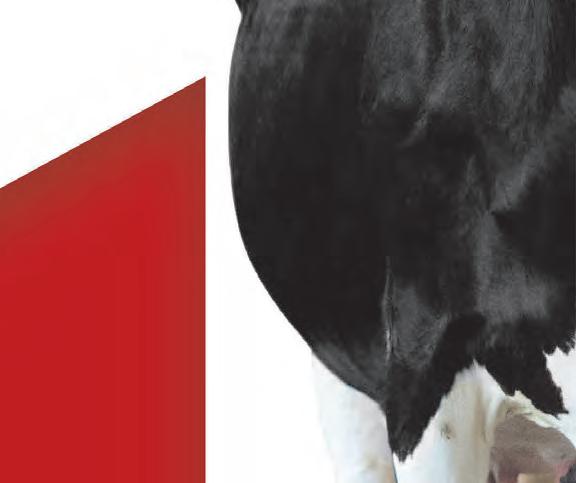
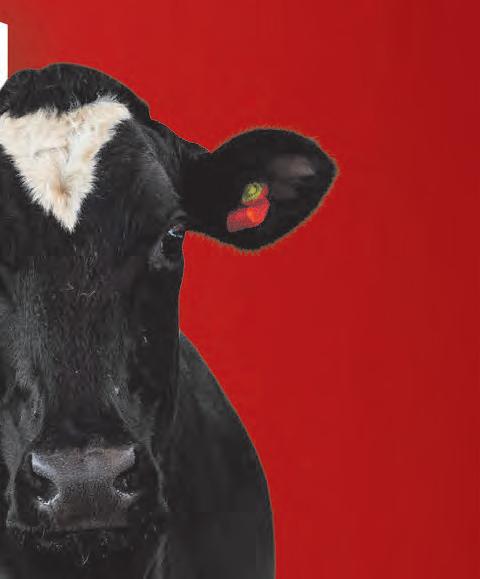





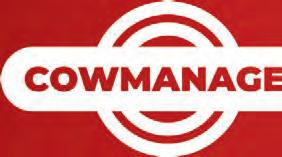

AHEAD OF THE HERD TOGETHER
Q2 A4 Ad Template.indd 3 18/04/2023 12:08:08
Born to chat about dairy
BY SOPHIE BALDWIN
CHLOE BROWN is the first person to admit she loves nothing more than a good chat — throw in a love of dairying and you have got yourself the perfect host for a podcast More than Milk
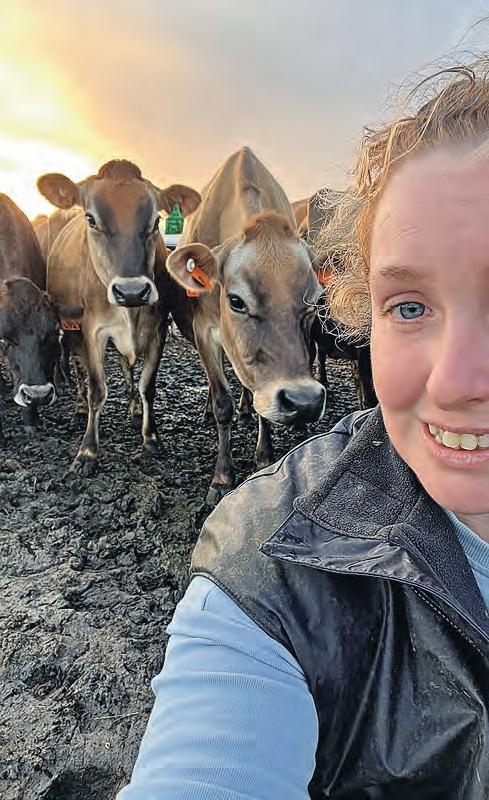
Chloe started her podcast not just because she wanted to celebrate all the wonderful people in the dairy industry, but also change the narrative.
“We often hear a lot of negative things when it comes to dairy but there are so many great people doing great things and now, I get to share these stories through my podcast.
“It’s the perfect medium,” Chloe said.
As an avid consumer of podcasts herself, Chloe loves nothing more than grabbing her two mikes and her mixer and hitting the road.

“You always get a better story when you sit down with someone in the same room. You can see the body language and the conversation just seems to flow better.
“I have spoken to so many great people and I believe there is real value in sharing people’s
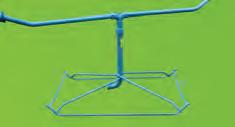


stories — I have a very long future guest list in front of me,” she laughed.







To date, Chloe has just released podcast number 16 and the diversity of the industry means no two farm chats have ever been the same.




“Emma Bant was my first ever podcast. She grew up on a farm and always had aspirations to take over the family business — her story includes raising four kids, a marriage breakup, a new partner and a desire to increase on farm efficiency by 20 per cent every year — my next podcast with Emily Walsh is a completely different story.”
And that is why Chloe loves talking to dairy people and hearing their stories.
“You can always learn from someone else and the way they run their business and face challenges.”




Chloe’s own passion for the dairy industry is extraordinary considering she doesn’t come from a dairy background, she grew up with sheep and beef.

“When I was young I was told I was too smart to study agriculture which is just a load of crap now,” Chloe said.

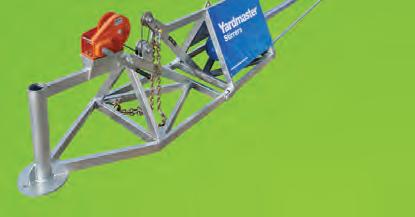
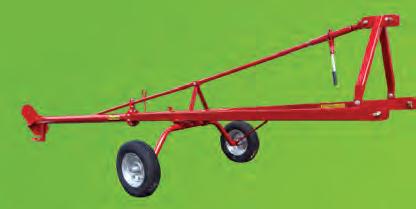
She fell in love with dairy when she met her husband Rodney at university where she was studying bio-medical science (incidentally Rodney grew up just 15 minutes away from Chloe but she never met him until uni).
“Rodney was never going to move away from the farm and the best decision I ever made was to join him — 10 years ago I knew nothing about dairying,” she said.
Chloe and Rodney currently lease the farm at Kirkstall in south-west Victoria from Rodney’s parents Lynette and Jim.
They milk 220 Jersey cows on 121ha, with an additional 12ha used to run young stock.

“We are landlocked here so we don’t have any future growth potential, but that’s okay, we are happy to keep things at a level we can manage ourselves.”
















With two young children, Chloe and Rodney farm to suit their lifestyle and that includes a later morning milking start than most other farmers.


“We usually don’t start until 7am because we don’t like early mornings and we don’t start again until 5pm in the afternoon and that works for us.”
She said they have only just survived a hectic calving season and are looking forward to a bit of downtime.
Around five years ago they instigated some big changes to the management of the farm, changing the herd from Friesian to Jersey, changing to a rotational grazing system, implementing new technology and focusing on animal welfare.

The herd is calved from February to April.

“We have found Jerseys do better if calved earlier. They are a lot harder to grow out once the rain sets in here.”
There have been family talks around a succession plan but Chloe and Rodney aren’t in any sort of hurry.
“We aren’t rushing things. We are in it for the long game and it will happen at some point.”
In the meantime, Chloe will continue farming and putting out her podcasts when she can.
“To me it has always been about sitting down and listening to other people’s stories, the publishing of a podcast is just the bonus,” she said.
 Chloe and Rodney currently lease the farm at Kirkstall in south-west Victoria from Rodney’s parents Lynette and Jim.
With two young children, Chloe and Rodney farm to suit their lifestyle and that includes a later morning milking start than most other farmers.
Chloe and Rodney currently lease the farm at Kirkstall in south-west Victoria from Rodney’s parents Lynette and Jim.
With two young children, Chloe and Rodney farm to suit their lifestyle and that includes a later morning milking start than most other farmers.
8 // DAIRY NEWS AUSTRALIA JUNE 2023 NEWS 6 Ashenden St, Leongatha, Victoria PHONE +61 3 9739 6521 www.dairypumpingsystems.com.au END OF FINANCIAL YEAR Supported by a Nationwide Dealer Network WAREHOUSE CLEARANCE 2023 GREAT SAVINGS OFF ‘CURRENT’ DPS PRICING FOR... • Valid for month of June 2023 ONLY • Only while stocks last • Pricing excludes GST & Freight • Contact DPS to find your Local Dealer SALE CONDITIONS $11,700.00 (save $1,350.00) 6.5m c/w drive shaft & pins x1 in stock x1 in stock x1 in stock x2 in stock 7.5kW 3 phase 7.5m long Williams PTO Stirrer Yardmaster Yardmaster PTO Pump Yardmaster Irrigator on Sled $1,900.00 (save $521.00) $15,100.00 (save $1,786.00) $11,700.00 (save $1,388.00)
Chloe Brown’s passion for the dairy industry is extraordinary considering she doesn’t come from a dairy background. She fell in love with the industry when she met her husband Rodney, a farmer, at university.












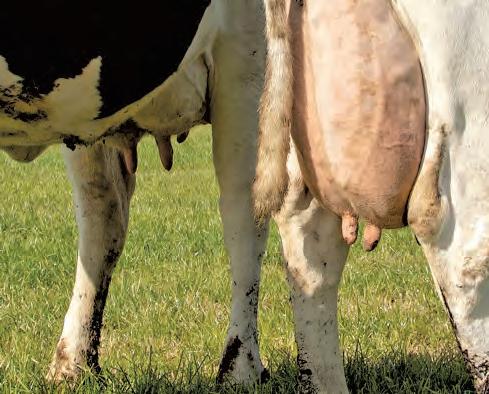



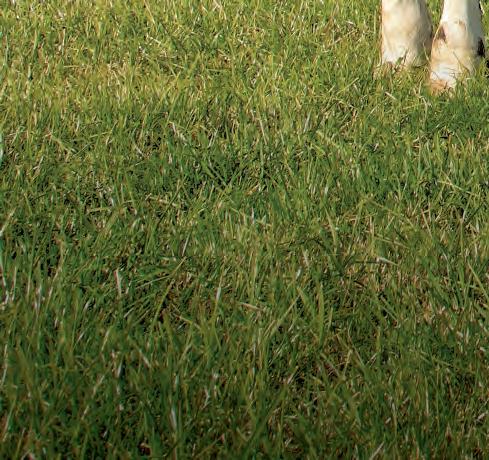

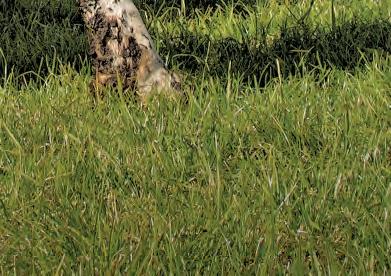

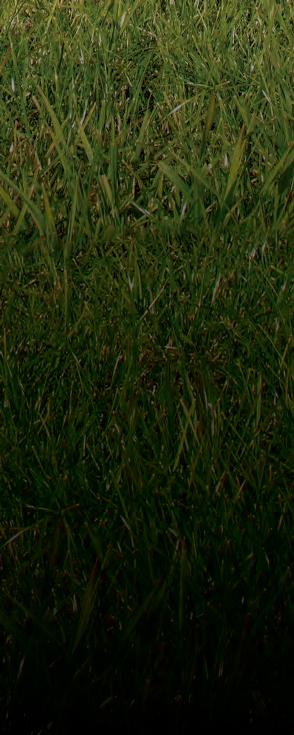
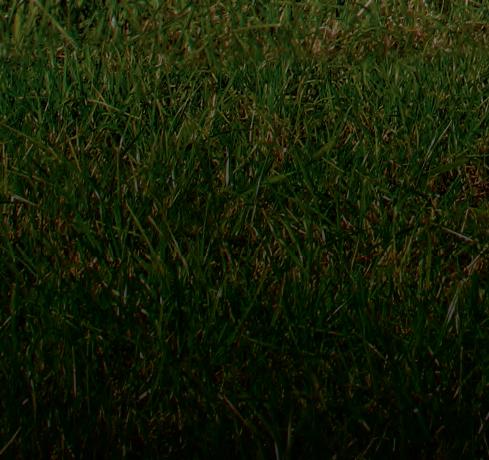




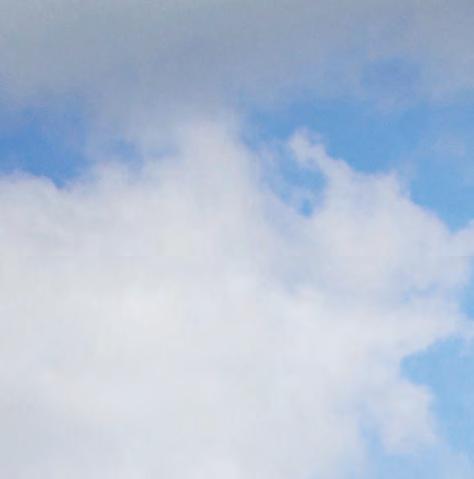














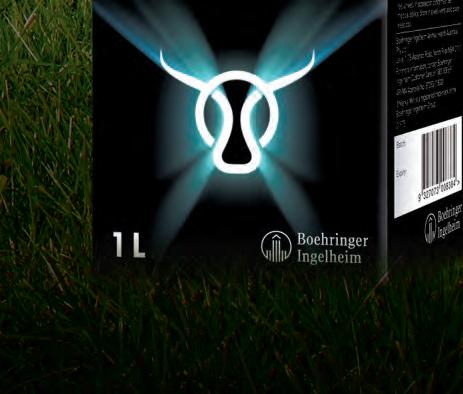





There is uncertainty around how renewed funding for the Commonwealth Government’s animal welfare strategy will be used, says Australian Dairy Farmers in the wake of the 2023 federal budget.
Mixed bag for dairy
BY GEOFF ADAMS
BIOSECURITY CHARGES are up and steps are being taken to open up the Pacific Area Labour Movement scheme which is designed to provide labour for agriculture.
Australian Dairy Farmers president Rick Gladigau said the federal budget addressed many of the key priorities for dairy farmers’ national policy and advocacy organisation, however ADF believed there were some areas of concern for dairy farmers.
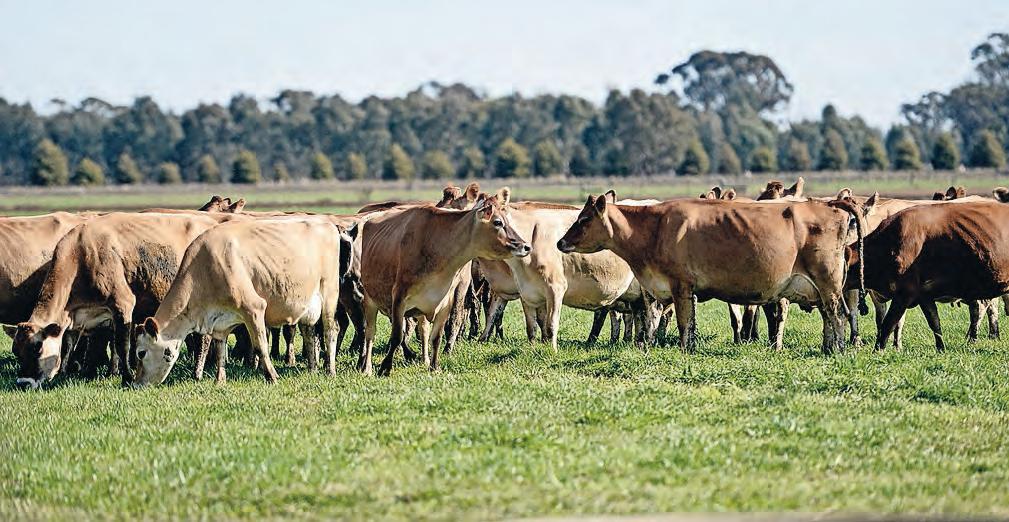
Mr Gladigau said the extra funding for biosecurity announced in the budget delivered in part on ADF’s submissions to the Senate’s recent biosecurity inquiry.
However, he said it was unclear how the biosecurity protection levy would be calculated and how the revenue raised would be collected and allocated.
“We appreciate that biosecurity is a shared responsibility, and all risk creators and beneficiaries need to pay their fair share.
“Based on this premise it is difficult to understand why farmers and importers of low-value cargo are the only people bearing new costs and levies,” Mr Gladigau said.
“Surely, the importers of high-value cargo must also bear some of these costs.
“It is appropriate that the government funds biosecurity because the economy benefits from strong biosecurity.
With changing regulations for silage coverage, try using the Surefoot® Silage Mat instead of messy, used car tyres.


The Surefoot® Silage Mat weight is farmer and cow friendly. Weighing 17kgs, requires one person to place and won’t hold water or hide any nasties.
100 mats will replace 500 car tyres. No more piles of tyres taking up space, stacks neatly on a pallet when not in use.
“However, biosecurity funding is fairer when everyone who creates a risk also contributes funding.
Following the first comprehensive review of biosecurity cost recovery since 2015, further increases to existing increased charges from July 1 are expected to generate about $36 million.
“These changes are essential to restoring the integrity of cost recovery arrangements for biosecurity services that the government provides,” the Department of Agriculture budget statement said.
By 2024-25, importers will pay more than $390 million or about 48 per cent of total biosecurity costs.
Mr Gladigau said initiatives to improve access to foreign workers and address the workforce shortage were welcomed, together with improvements to how the Department of Home Affairs processed visas.
“Other long-overdue initiatives that have been addressed include a review of the Australian Carbon Credit Unit scheme, the development of a climate adaptation plan and a commitment to fund the Australian Bureau of Agricultural and Resource Economics and Sciences to improve data collection.”


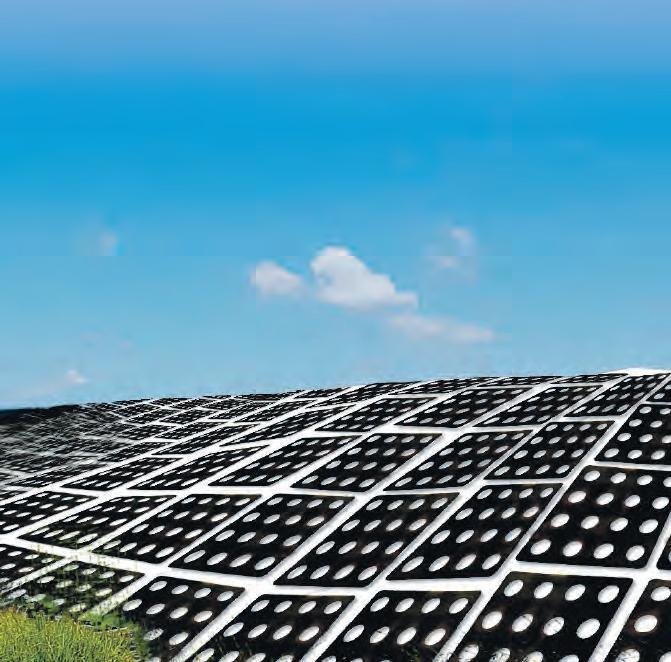
However, ADF notes there are some shortcomings in other areas for dairy farming.
“There is uncertainty around how renewed funding for the Commonwealth Government’s animal welfare strategy will be used, and the government continues to withdraw investment from water supply projects,” Mr Gladigau said.
“These two issues will broadly restrict confidence in the dairy industry.
“Meanwhile, the rise in the heavy vehicle tax will certainly be an impost on dairy farmers as freight costs will increase for milk, hay, grain and everyday needs, and these are likely to be passed on to farmers.”
ɋ More responses to the federal budget, page 36.
10 // DAIRY NEWS AUSTRALIA JUNE 2023 NEWS
Sales Hotline:1800 255 943 www.surefootmat.com.au RPS Industries P/L - 8 Venture Way, Pakenham, Victoria 3810 Ph: (03) 5623 3391 1130mm 150mm ®
Bega’s pro t lower in rst half
BY GEOFF ADAMS
DESPITE RISING revenue, Bega Cheese reported a lower profit result compared to the previous year, for the first half of this financial year.
It’s interim report for the period ending December 2022 recorded earnings before interest and taxation of $20 million compared to $42 million the previous year.
The normalised result was $23 million, compared to $51 million in the previous year.
The group’s revenue exceeded $1.6 billion, an increase of 11 per cent on the prior year.

The first half report noted the impact of higher prices being paid for farm gate milk, which reflects strong global dairy commodity prices last year.

In the first half of the current year these cost pressures exceeded the level of price realisation that could be achieved in the Australian domestic market due to the lagged impact of price increase realisation.
“Prices in the Australian market now reflect the significant change in farm gate milk pricing that occurred on July 1,” Bega Cheese executive
chairman Barry Irvin said.
Despite the stronger prices, milk supply across Australia declined by seven per cent in the current period.
He noted the dairy industry had been impacted nationally by labour shortages, flooding, high land prices and the attraction of high prices in other agricultural commodities including beef.
Bega has ceased manufacturing at its Griffith factory and transferred the milk intake to the Penrith facility.
The company had historically been sending Canberra milk to the Griffith factory (previously known as Capitol Chilled Foods), however given there were no dairy farms in Canberra and milk had been sourced from outside the region, it made sense to make the transfer, the company said.
“The changing nature of the dairy market within the ACT has meant that Bega’s Griffith facility had not been operating at its full capacity for some time,” Mr Irvin said.
He said the company was working with the 19 employees affected by the announcement and will provide redundancy packages or redeployment where possible.
FONTERRA NZ RECORDS MAJOR PROFIT
Fonterra New Zealand has announced a billion-dollar profit for the third quarter of this financial year.

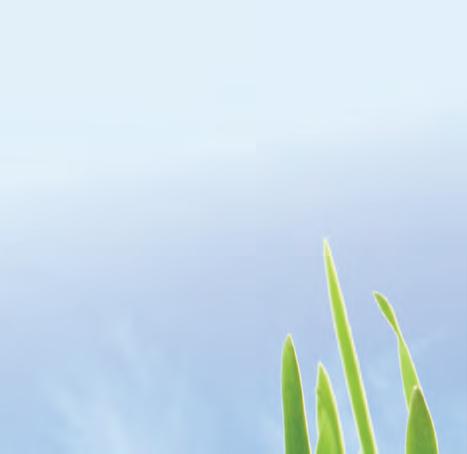
Fonterra NZ also announced an opening 2023-24 season forecast farm gate milk price of NZ$7.25 to NZ$8.75/kg of milk solids, with a midpoint of NZ$8/kg MS.
Fonterra NZ chief executive officer Miles Hurrell said while the forecast farm gate milk price for this season had been impacted by reduced demand, the cooperative remained on track for a strong full-year dividend.
Mr Hurrell said the reduced short-term demand, particularly from China, has had an impact on the company’s 2022-23 forecast farm gate milk price.
“Global Dairy Trade prices have not recovered to the levels required to hold the previous midpoint for this season,” he said.
“For these reasons, we have narrowed the forecast range for the 2022-23 season from $8-$8.60 per kg MS to $8.10-$8.30
per kg MS and reduced the midpoint from $8.30 per kg MS to $8.20 per kg MS.”

Fonterra NZ has reported a profit after tax of NZ$1326 million, equivalent to 81 cents per share, for the third quarter of the 2023 financial year.
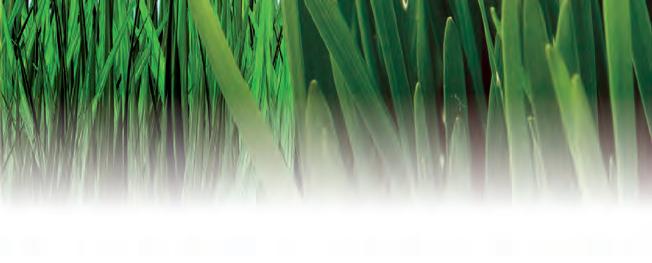
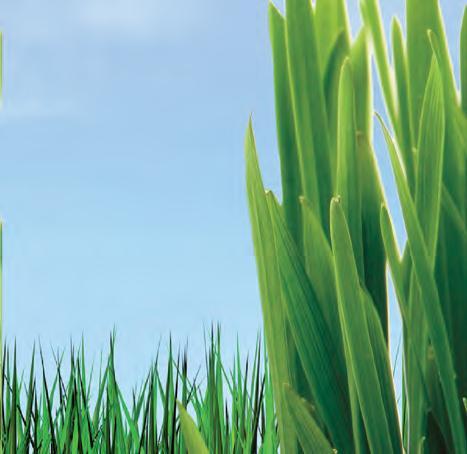
This is up NZ$854 million on the same period last year and includes the gain on sale from Soprole of NZ$260 million.


“Excluding the net gain from divestments, our normalised profit after tax improved on last year, up $606 million to $1078 million, equivalent to 65 cents per share,” Mr Hurrell said.

“This is due to strong performance in our ingredients channel, with continued higher margins in our cheese and protein portfolio, particularly casein and caseinate.
“These favourable price relatives have continued longer than expected, and we’re also seeing improved performance coming through in our foodservice and consumer channels, in particular in global markets.”
 A new line being promoted by Bega with Vegemite.
A new line being promoted by Bega with Vegemite.
// 11 DAIRY NEWS AUSTRALIA JUNE 2023 NEWS www.sumitomo-chem.com.au ProGibb® is a registered trademark of Valent BioSciences LLC, a Delaware limited liability company. WANT TO FILL THE WINTER FEED GAP? can generate 30 - 60% more dry matter within 3 weeks of application. For more information on ProGibb SG please scan here
HOTCOWTM HEAT DETECTION TAGS
• Accurate, easy-to-use tag for detecting cows in standing heat
• Available in five colours: Blue / Green / Pink / Red / Yellow
TRANSITIONTM CALCIUM BOLUS
Choose the calcium supplement specifically formulated for transition dairy cows.
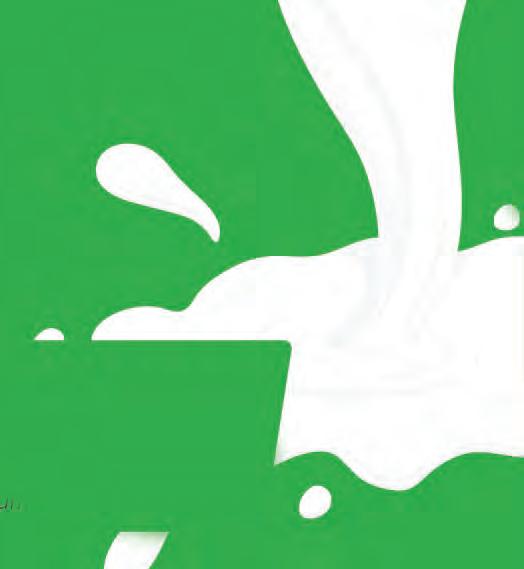
TransitionTM Calcium Boluses are the first products in a line of nutrition supplements for close up and transition dairy cows. Easy to administer, safe for the animal and helps prepare cows to enter the milking herd in a normal time frame.
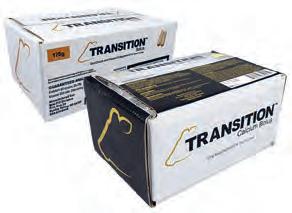
Biosecurity funds allocated
AGRICULTURE VICTORIA scientists are working with Timor-Leste officials to boost animal health and help safeguard Australia from exotic animal diseases.
The Australian Department of Foreign Affairs and Trade has funded Agriculture Victoria $3.5 million over five years to extend biosecurity training to scientists, technicians and farmers in Timor-Leste, building on work undertaken during the past three years.
078 048
GreenCon Concrete
& Construction
www.greencon.com.au
• Feed pads & freestalls

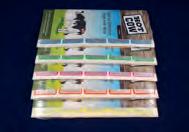
• Steel construction
• Dairies & farm sheds
• Effluent systems

The fastest and most efficient way to clean your yard. Our tanks are specifically designed to withstand the high volume of water and flow rates to successfully clean your yard. They can be opened by a manual valve or a pneumatic valve which can be controlled in the dairy.
Cobden Floodwash
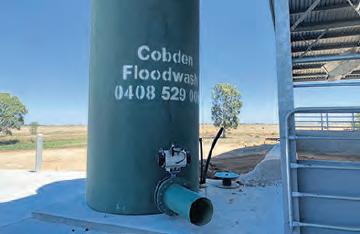
1 Station Street, Cobden VIC, 3266
ph 0408 529 009
www.cobdenfloodwash.com.au
The project, which initially focused on diagnosing and managing African swine fever, has been extended to look at a range of diseases including classical swine fever, foot-and-mouth disease, and lumpy skin disease, and will include testing of all livestock species.
Agriculture Victoria research leader Grant Rawlin said the biosecurity and emergency animal disease work supported by Agriculture Victoria had enabled Timor-Leste to diagnose and control disease outbreaks which may have otherwise cost the agriculture industry up to an estimated $90 million.
“Agriculture Victoria is proud to have supported Timor-Leste’s ability to successfully diagnose and control several animal disease outbreaks within 48 hours,” Dr Rawlin said.
“The timely diagnosis and control of animal disease outbreaks means less livestock are impacted, the disease doesn’t spread as far, and farmers can quickly resume their operations.”
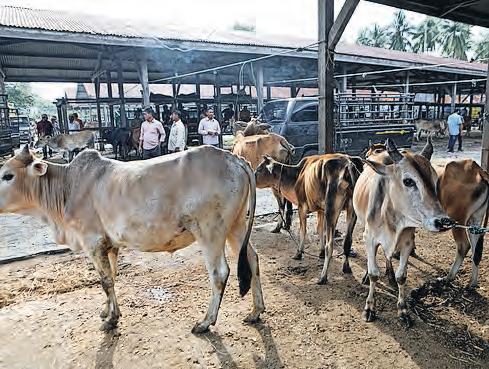
Dr Rawlin was on-the-ground during the 2019 African swine fever outbreak in TimorLeste and recently spent a month leading a team training veterinarians on how to use a range of diagnostic tools, including a realtime method for detecting different microbial agents in animal samples, and a highly specific, low cost, fast and portable test for pathogenic viruses.
The Australian Department of Foreign Affairs and Trade has funded Agriculture Victoria $3.5 million over five years to extend biosecurity training to scientists, technicians and farmers in Timor-Leste.
EPA
Caitlin Wilson, Chargé d’Affaires at the Australian Embassy Dili, said the initiative demonstrated Australia’s deep and enduring commitment to supporting Timor-Leste’s food security and economic priorities.
“Maintaining a healthy, productive and profitable livestock industry not only contributes to jobs and economic development for Timor-Leste, but also helps meet domestic demand for nutritious protein,” she said.
“Australia is proud to be working with our Timor-Leste partners to strengthen their biosecurity systems as part of regional efforts to combat exotic animal pests and diseases such as African Swine Fever, foot-and-mouth disease and lumpy skin disease.”
The program also includes sponsorship of Timorese veterinarians and researchers to visit Agriculture Victoria research sites in Australia to undertake research alongside our staff and expand their knowledge. Vets and scientists are visiting AgriBio over the next few months.
VR1840204
“The collaboration has bolstered the local agriculture industry’s response efforts and deepened our relationship with Timor-Leste. It also gave our experts invaluable insight into on-the-ground emergency animal disease management and control.”
The Federal Government investment of $3.5 million was launched at the Timor-Leste Veterinary Medicine Association conference in Dili in March.
ɋ For more information, visit the Agriculture Victoria website.
AUSTRALIA’S MOST ACCURATE* HERD IDENTIFICATION SYSTEM
Herd Identi cation
Very accurate animal identi cation system for Rotary and Herringbone dairies. Simple to use, this is the complete herd management system no dairy farm should be without.
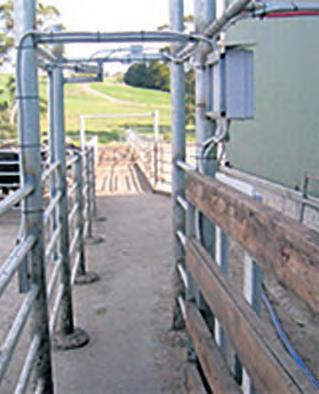
Sorting and Drafting
Save time and labour with our sorting system that can be integrated into your Rotary or Herringbone ID system or operate as a stand-alone system for sorting only. Animal ow and accuracy is excellent with maximum exibility and speed.
Sensors and Heat Detection


Volume, cell count, fat, protein and heat sensors can be integrated into the Jantec ID system. Improve your herd health, production and milk quality with this leading technology.
If you want to increase productivity, quality and have Australia’s best herd management system, contact us today!
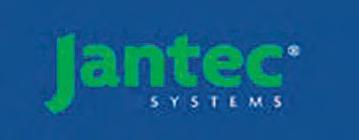
12 // DAIRY NEWS AUSTRALIA JUNE 2023 NEWS CGS ELECTRO-EJACULATOR & BULL PROBE • An electronic control unit with vinyl jacket and carry strap • Rechargeable sealed 12V Battery & 240V Battery charger • Various probes and spare parts available CITO THAW UNIT Electronic 12-220-Volt AC digital unit heats and maintains accurate water temperature for thawing. Includes: Glass lined thermos, adjustable heat settings, accurate thaw monitor temperature indicator, fitted retrieval basket, power cord STOCK AVAILABLE: CONTACT THE OFFICE ON 1800 6147 860 FOR PRICING OR CONTACT YOUR LOCAL SALES REPRESENTATIVE VIC, TAS & S/W NSW -NOEL FORREST : CENTRAL NSW-CHRIS MIEKLEJOHN: QLD & NTHRN NSW - TIM KIRK: STOCK AVAILABLE: CONTACT THE OFFICE ON 1800 647 860 FOR PRICING OR CONTACT YOUR LOCAL SALES REPRESENTATIVE: VIC, TAS & S/W NSW - NOEL FORREST - PH: 0402 432 771 CENTRAL NSW - CHRIS MEIKLEJOHN - PH:
QLD & NTHRN NSW - TIM KIRK - PH: 0427
Photo:
0427 310 245
* as independently veri ed (03) 5222 8891 www.jantecsystems.com.au Specialists in CellSense and YieldSense+ technologies
Ph: (03) 5595 1078 info@greencon.com.au 1 Station Street, Cobden West Crt, Warrnambool
System pays its way
BY RICHARD MEREDITH
OFTENTIMES THE best advertising is just speaking to your neighbour from down the road.
Hearing about their positive experience can be the last bit of encouragement you need to take the next step for your dairy and venture into cow monitoring.
And truly, there is no better endorsement of the CowManager system than the words of Henry Bevan, when he says: “I wish I’d done it 10 years ago.”
Henry and his wife Anna own and manage their Bevandale dairy farm at Ravenshoe on Queensland’s Atherton Tablelands.

Henry is the fifth generation of the family to run the farm, having taken over two and a half years ago when his father, John, passed away.
One of eight children, Henry and Anna also took on the care of his two younger sisters, aged 17 and 13.
They have two children of their own aged four and two and one on the way.
The Bevans introduced CowManager in October 2021.
In the months of operation ever since, they have come to rely on the system entirely for heat detection.

“We have sensors on all the cows,” Henry said. “They pick up many more cows than I would have.”
Less empties
The number of empty cows on the pregnancy test has dropped from between 15 and 20 per cent to just zero to five per cent due to more accurate heat detection and insemination timing.

Henry estimates they are a good three weeks ahead on in-calf rates which has flow-on benefits to calving dates and getting cows back in milk.
The Bevans milk 200 cows in an all-yearround milking herd supplying the Bega factory at Malanda.
Since taking over the farm they have begun switching the herd from 100 per cent Holstein to 50 per cent Jersey and 50 per cent Holstein. “Jerseys are overall easier to manage,” Henry said.
“They are less maintenance; they get in-calf easier, and they eat less feed for a similar amount of milk solids as Holsteins.”
The CowManager system contributes to managing the health of the herd, picking up any sick cows well before they are showing clinical signs of an ailment.
This ensures the individual cow can be treated earlier, which in turn means less medication and fewer vet calls.
“One of the reasons we chose the CowManager system was because of the tags,” Henry said.

“We prefer them to the collars for ease of handling.”
Delivered in four weeks
In the time since they have had the CowManager system installed, Henry said they were well in front on both service and cost.
“The support from World Wide Sires and from Chris Kendall in particular has been first rate. If there’s a software or internet issues, he’s often on to it before I’m even aware of it.

“And it took just four weeks from order to installation, which is pretty impressive.”
The Bevan’s dairy herd is fed a partially mixed ration, combining grazing and corn silage that is grown on the farm as a summer crop, and is fed out all-year-round.
Each year they breed about 150 replacement heifers, selling on any that are surplus to their needs to other dairy farmers.
Paying for itself in profit and labour
As new technologies continue to change the face of dairy farming, their real impact can best be measured at the coalface.
“For me personally, I don’t have to worry any more about catching heats or cows getting sick,” Henry said.
“I get an alert on my mobile wherever I am, and I can attend to it immediately.”
According to Henry, the app isn’t hard to use or navigate at all.
In fact, it’s as easy as can be and it saves him a lot of labour.
“It’s actually a really great app. It’s another set of eyes for me. I recommend it at every chance I get. It’s paid for itself in no time.”
LOAN HELPS NEW FARMS TO GET GOING
As the only Federal Government funded, low-cost loan available to support the establishment of new farm businesses across Australia — and two years since first it was offered through the Regional Investment Corporation — AgriStarter Loan is helping to accelerate first generation and next generation farm businesses to start-up, set-up and grow.
RIC’s commitment to growing the Australian agricultural industry has delivered about $40 million in AgriStarter Loans.
“The loan can be used to start and develop a first farming business, develop a share farm or farm leasing business, or to assist with succession planning for intergenerational transfer of farm
SKIOLD DISC MILL THE ORIGINAL
business assets,” RIC chief executive officer John Howard said.
The loan has been specifically designed to support the growth and development of farming businesses in Australia and offers five year, interest only laons with affordable interest rates and no application fees.
RIC variable interest rates are determined by the 10-year Federal Government bond rate and reviewed only twice a year so business owners can better manage their cash flow to prosper and grow.

The AgriStarter Loan is available to all eligible farmers across Australia and can offer up to $2 million.
To apply for the AgriStarter Loan or for more information, visit ric.gov.au or contact RIC on 1800 875 675.
SKIOLD VMS
CLASS LEADING GRAIN MILLING TECHNOLOGY
UNPARALLELED MILLING EFFICIENCY AND ENERGY
CONSUMPTION
BETTER UTILISATION OF YOUR GRAIN EUROPEAN QUALITY AND MANUFACTURED MULTIPLE DISC MILL SIZES AVAILABLE


 Henry Bevan, with he and his wife’s two children, says he has come to rely on the CowManager system entirely for heat detection.
Henry Bevan, with he and his wife’s two children, says he has come to rely on the CowManager system entirely for heat detection.
// 13 DAIRY NEWS AUSTRALIA JUNE 2023 NEWS
www.vacmillsolutions.com.au Email: sales@vacmillsolutions.com.au CALL US TODAY: Tel: 07 55 477 588
TO A SKIOLD VMS REPRESENTATIVE ABOUT YOUR NEXT FEED MILL Flexible Augers • Pencil Augers • Mixers • Cleaners • Control Systems Complete feed systems also available
SPEAK
Flood warning network set up
A NATIONAL flood warning network to improve protection for at-risk communities and potentially save lives will be launched in Queensland — the state most prone to natural disasters.
The Federal Government will spend $236 million in the next decade to set up the network, with the Commonwealth to buy and upgrade flood gauges from local, state and territory governments.
It will also outlay an additional $8.6 million to create the country’s first national emergency stockpile to improve the ability of emergency teams to respond to disasters.
The project will be kick-started in Queensland, where more lives have been lost in raging floodwaters than in any other Australian state or territory.
The investment follows advice from independent inquiries following the disastrous 2022 flood season that the Federal Government assume responsibility for the flood-gauge network, which has been previously described as patchwork.
The new system will mean more accurate flood readings and data to enable improved warning messages to save lives and help protect property.
Federal Environment Minister Tanya Plibersek said the upgrade to the network would give more accurate information on flood risks to communities as well as emergency services.
“A lot of those older gauges are really near the end of their life. They can't be read remotely, which is a real problem,” she said.
“We need to be able to read them remotely, particularly in dangerous times.
“The better the flood gauges, the more warning we can give to communities and to emergency services personnel about approaching floodwaters, the more opportunity people have to prepare for the worst.”
At present, one-third of flood gauges are owned and managed by the Bureau of Meteorology, while the remainder are split between state and territory governments as well as local councils or individuals.
Work on flood gauge repairs will begin first in Queensland, following advice from the bureau due to the state’s high flood risk.
The northern NSW town of Lismore experienced some of the worst flooding during 2022 and Ms Plibersek said the area would also be a focus of upgrades.

“We're working with the NSW government on the next steps there. We’re very keen to see northern NSW in particular prioritised,” Ms Plibersek said.
“Sadly, three-quarters of the deaths that
have happened in flooding in recent years have been in Queensland and NSW and about three-quarters of the economic cost of flooding has been in Queensland and NSW.”
Upgrades to high-priority catchments can begin in every state and territory as costsharing arrangements are agreed to.
Federal Emergency Services Minister Murray Watt said he had lost count of disaster victims who had said the current warning system was inadequate.
“One of the most common complaints we receive is that people just didn’t have the warning they needed about impending floodwaters to save themselves, to save their properties, to save their animals,” he said.

“These sorts of investments will go a long way to making sure that we can keep Australians much more safe into the future.”
Senator Watt also said the national emergency stockpile would allow access to essential items including emergency housing, water purification systems and emergency sleeping materials.
Queensland Emergency Services Minister Mark Ryan welcomed the network funding announcement and said it would improve community safety around the country.
“The investment that they're making will ensure that communities are safer, communities are better prepared for natural disasters and when natural disasters strike, communities are equipped and resilient to respond to those natural disasters,” Mr Ryan said.
A national flood warning network will be set up after advice from independent inquiries following the disastrous 2022 flood season that the Federal Government assume responsibility for the flood-gauge network.
14 // DAIRY NEWS AUSTRALIA JUNE 2023 NEWS
Photo: AAP/Jason O’Brien











































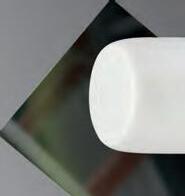


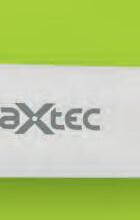



THE HEALTH SYSTEM that future-proofs your dairy farm. For higher profitability AND a healthier herd! CONTACT US TODAY FOR MORE INFORMATION! Lallemand Animal Nutrition | E: LAN-Aus@lallemand.com | T: +61 7 5451 0125 consistent MILK YIELD fewer MASTITIS CASES reduced ANTIBIOTIC USAGE a better INSEMINATION INDEX easier CALVINGS comprehensive COST SAVINGS reduced WORKLOAD & STRESS The unique smaXtec bolus technology provides you with unparalleled data and insights into your herd‘s health. HEALTHIER COWS ENABLE: YOUR BENEFITS: overview of each cow’s drinking behaviour early indicator for reduced milk production · immediate detection of irregularities in water provision, e.g. contamination, stray current · increased animal health Brand new: smaXtec TruDrinking The world‘s first technology for quantifying water intake! Measure water intake PER COW. SUCCESS STORIES from customers around the world
Proven results in Top Dairy Business throughout the World

Here's what Leading dairy producers are saying about Jefo's Protected B Vitamin Solutions:
“Since starting on the Jefo Dairy Solutions, we have reduced issues around calving. The cows are heathier and there is a huge improvement in fertility . I recommend these products for every farm.”
Wandilla Holsteins, 450 Holstein cows Leongatha North, Vic
“At Comestar we have used the Jefo Solution for Transition for the past 16 years. We have seen major improvements in Reproduction, ease of calving, fertility and overall cow health and performance. Every Dairy Farm needs to use it. It is REALLY that good!”
“We have been using the Jefo Solutions for Dairy for over 12 months and have seen some great results. Cows are Transitioning really well and Fertility is Fantastic . We will keep using these solutions.”
Mark Dee, 430 cows Clydevale Holsteins. Northern Vic


CYCLEReproduction ausinfo@jefo.com | 07 4630 1500 Razaq Balogun: 0419 942 811 : Edwin Van Ravesteyn: 0427 992 335 Want to enhance reproduction in your herd? Jefo’s specific blends of protected B-Vitamins synergistically improve reproduction. Move your business forward
Marc Comtois Comestar Holsteins, Quebec, Canada.
Proof is in the pasture
MAX WAKE owns and runs the Benleigh Brown Swiss dairy farm at Whittingham in the NSW Hunter Valley region where he milks 270 cows.
Max is very well regarded in the dairy industry — he has captured the champion cow title in the prestigious International Dairy Week awards on four separate occasions, presented the first Brown Swiss to be awarded best cow at the Sydney Royal Easter Show and his long list of triumphs at the Singleton Show may never be matched.

Max was an early convert to ProGibb SG and has been using it now for more than 15 years.
When we asked why, Max said, “You can’t afford not to use it.”
“The response from the feed growth is terrific, especially when combined with fertiliser,” he said




“We like that it is compatible with EasyN and we can use them in the one mix.”














When asked what percentage improvement in dry matter he was seeing with ProGibb SG, Max was quite effusive.
“It’s fairly dramatic, I haven’t actually measured it, but if I said somewhere between a 50 and 100 per cent improvement, it would be my educated guess,” he said.

Measurements by agronomists report from 20 to 60 per cent improvement as quite common.

One of the other benefits that Max reported was the ability to manage good paddock rotation throughout the winter period.
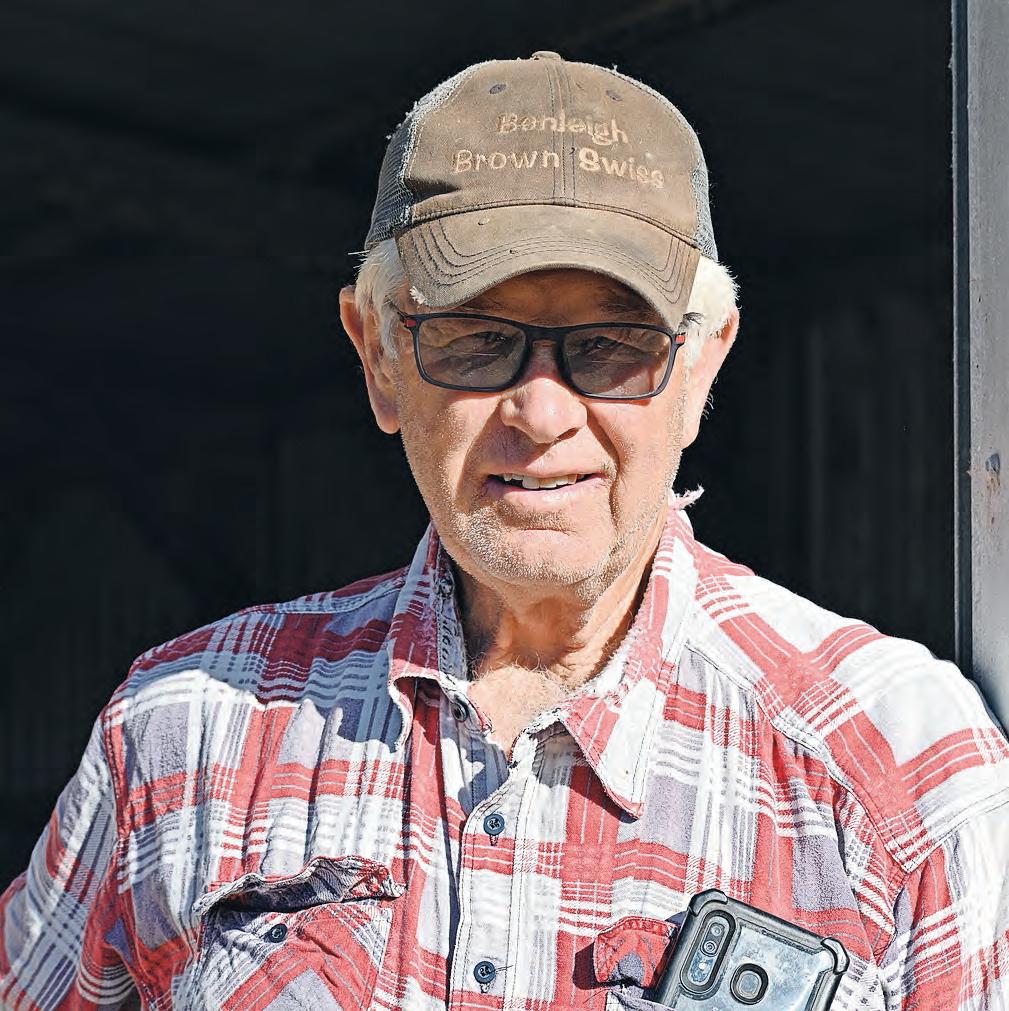
Max said he would encourage anyone considering using ProGibb this winter to go ahead with it.
“I would absolutely recommend it,” he said.







“I haven’t been using it for 15 years plus for no reason and wouldn’t keep using it if it didn’t work, as I said before, you pretty much can’t afford not to use it.”

For more information on ProGibb or to view more testimonials from users, scan the QR code on this page.
Max Wake was an early convert to ProGibb SG and has been using it now for more than 15 years.

// 17 DAIRY NEWS AUSTRALIA JUNE 2023 NEWS
Top sire delivers on traits
WHEN PAUL Mumford breeds dairy cows, he wants “everything”.

And it turns out this is exactly what South African and New Zealand Jersey breeders want too.
Paul and his wife Lisa from Gelbeado Park in Yarram, Victoria, bred Gelbeado Park Woodside (CSCWoodside), the ABS Australia Jersey sire with the highest number of exported semen straws this past year.
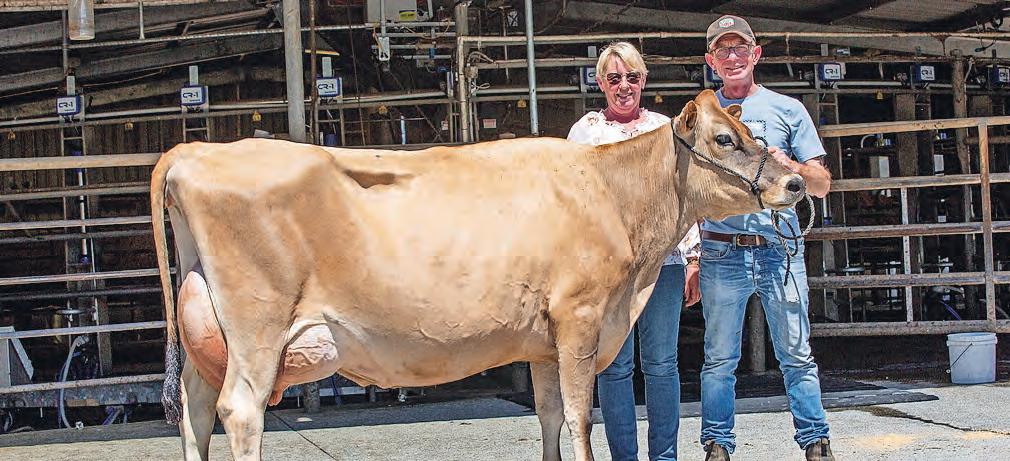
He was also the highest selling Jersey sire domestically this financial year.
“It is nice to know that people around the world will be using this bull and hopefully he delivers great animals that have longevity and improve the breed,” Paul said.
“Australian Jerseys — and our black and white counterparts — haven’t always been recognised for the great animals we have here, with farmers looking overseas to add to our genetic pool.”
Paul said Australian genetics were “flexible” as cows were able to milk with grass, other inputs, or a combination of both.
It’s this strong focus on cows fitting into an Australian — or specifically the Mumford farming system — that drives Paul’s breeding objective.
This system at Yarram is a predominantly spring calving, dryland, pasture-based dairy farm where cows are fed 1.4 to 1.6 tonnes of grain each — depending on the season.
With this in mind, it is no surprise that Paul believes he’s “fussy” when he says he needs everything in a cow.
“I want capacity, strength, ability to milk, likeability — one that doesn’t kick — and longevity, one that makes money,” he said.
“I’m pretty stringent on how I breed cows and pretty ruthless when it comes to improving my farming system.
“The CSCWoodside cow family has survived and regenerated for me and is achieving that long-term goal of where I am taking my farm system and genetics.”
A descendant of the Cowslip family, Paul specifically chased these genetics because they had a “formidable bloodline history” and were “genetically better”.
“I looked at their numbers, and this was before genomics,” he said.
“Their ABV (Australian Breeding Value) numbers were performing better than their expected parent average. The proof has been in the pudding, they’ve probably done me pretty well, breeding two bulls.”
A Nuffield Scholarship in 2009, studying genomics and its application in Australia, enabled Paul to expand his theory of “crunching the numbers” and investigating cow families that deliver progeny that are better than their expected parent average.
Genomics was introduced to the Australian dairy industry in about 2010 and this quantified Paul’s belief in concentrating on the numbers and improving his genetics with every generation.
He continues to employ this approach to breeding and combines it with a visual appraisal of each animal.

For him, the Cowslip family offered the best of both worlds — and this is reflected in CSCWoodside.
“It’s a very rare trait to have strength, capacity and milk together in one animal — normally we call that beef,” Paul joked.
“But it’s definitely something the Jerseys were lacking and that’s what made the Cowslips even more appealing.
“They had the ability to milk and visually showed strength and capacity, all in the one animal.”
CSCWoodside is Gelbeado Park’s third sire that’s entered the artificial insemination market.
Paul’s “humbled” by CSCWoodside’s success — both in Australia and across the globe — but he’d much prefer to breed cows, any day of the week. After all, they offer much more value to his milk production business.
Nevertheless, he’s making the most of CSCWoodside’s balanced proof as he strives for continual improvement.
“What I like about CSCWoodside is he’s the perfect bull for my herd. He’s going to deliver all the traits that I need to improve the core nucleus of my breeding herd,” Paul said.
“He will be my primary bull because the traits he displays are exactly what I need for my herd — strength, capacity and the ability to milk.”
•GROW MORE GRASS
•OPTIMISE YOUR FERTILISER
•MAXIMISE YOUR LIME
• TARGETED EFFLUENT DISTRIBUTION


•USE YOUR WORST PADDOCKS
•REFORM YOUR LAND
•INCREASE YOUR DSE
•PROGRESS TO CARBON NEUTRALITY
•REDUCE WATER LOGGING
18 // DAIRY NEWS AUSTRALIA JUNE 2023 NEWS
Paul and Lisa Mumford with Gelbeado Park Tahbilk Cowslip 5435 EX-93, the dam of CSCWoodside, the sire who is dominating semen export sales.
The A24 Goodnature Rat & Mouse Traps have everything you need to get on top of your rodent problem, with a rat and mouse trap that’s automatic, non-toxic and delivers a quick and humane kill. am.gallagher.com





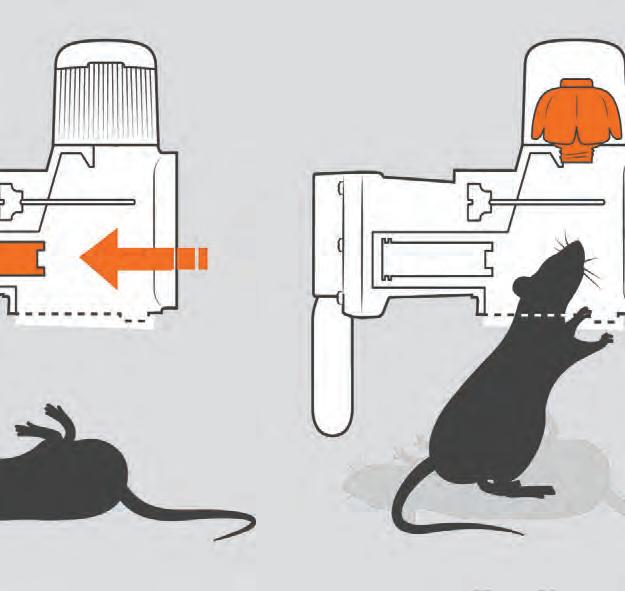
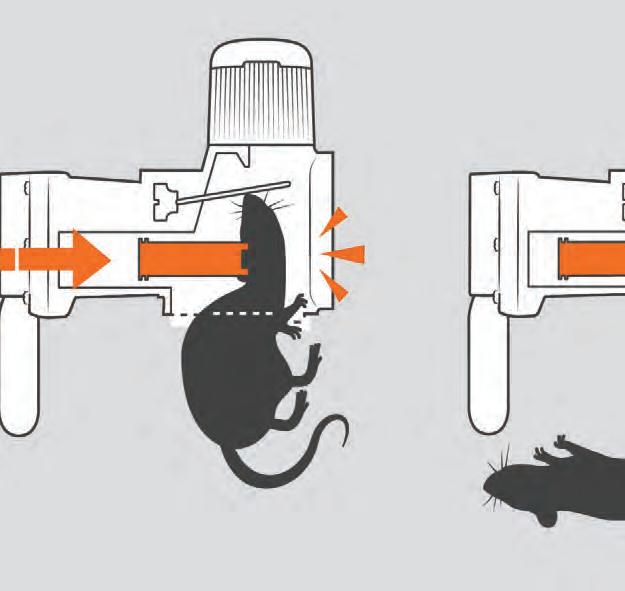
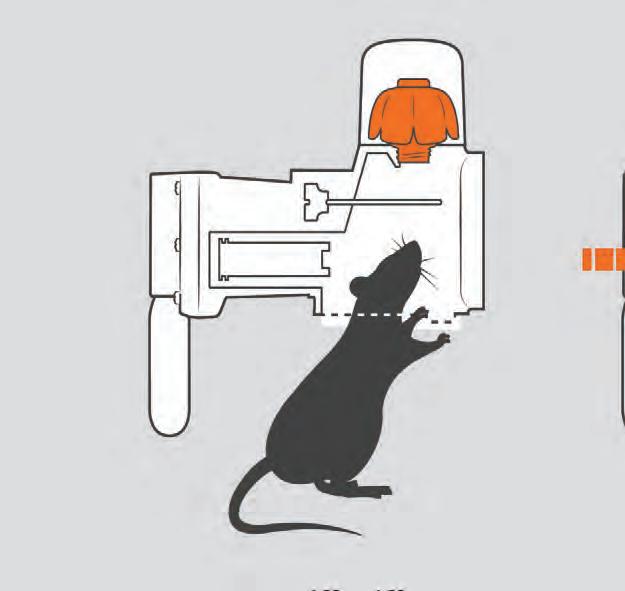
1800 425 524





SCAN TO LEARN MORE
Highly functional liquid and milk proce
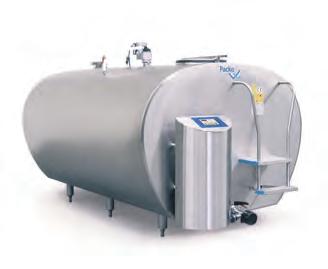

New CEO for trucking body
AUSTRALIAN LIVESTOCK and Rural Transport Association executive director Mat Munro has been appointed the Australian Trucking Association chief executive officer.

ALRTA national president Scott McDonald said Mr Munro had many successes while at the helm of ALRTA during the past 10 years.
“Mat joined ALRTA in May 2013 at a crucial point in our association’s evolution,” Mr McDonald said.
“He was our first direct employee and immediately set about revamping our operations.








“We now have a modern association with excellent governance, staff, offices, member equity and standing with governments and other stakeholders.
“Some of Mat’s policy achievements include improved work and rest flexibility for livestock carriers, new rules allowing personal use of a heavy vehicle ... a registered code of practice for effluent management and construction of several free effluent disposal facilities.
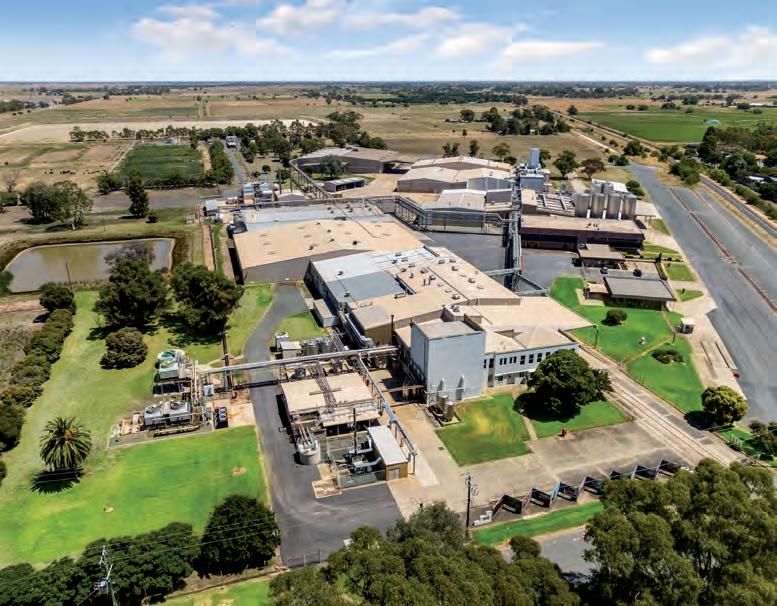
“However, all good things must come to an end, and so on behalf of ALRTA and our state member associations, I thank Mat for his great service to our industry and wish him every success in his new role with ATA.
“It is a position where his professional skills and his understanding of rural trucking can be put to good use. Our attention now turns to recruiting a suitable person to build on Mat’s success.”
Mr Munro starts with ATA on July 3.
20 // DAIRY NEWS AUSTRALIA JUNE 2023 NEWS Closing Friday 9 June 2023 at 4.00pm (AEST) For Sale by Expressions of Interest *(Approx.)^STCA – Total building area of 23,009sqm* – Total land area of 78.24ha* – Offered as vacant possession – Includes power substation – Opportunity for a range of different uses^ – Zoned industrial 1/ Zoned farming 1-65 & 85 Bosse Road, Tongala VIC For Sale
Australian Trucking Association chair David Smith and incoming chief executive officer Mat Munro.
ssing facility 0423 388 932 0407 826 542 Travis Hurst Rocky Gagliardi 0448 860 4450488 191 840 0488 167 173 Chris Lawlor Jock Grimshaw James Lawson THE DEDICATED MILK COOLING SPECIALIST • A Packo milk tank and system to suit all herd sizes, pick up schedules,and entry temperatures • Simple one button operation to activate either cooling or wash modes • Packo's Patented fully automatic Rotojet cleaning system, ensures every square in of the inside vessel is clean and hygienic. New & Secondhand systems/Wash system upgrades for any make-model tank Call Dairy-Tech Refrigeration today for a no hassle quotation PHONE 03 5662 3277 EMAIL pgoiris@dairytechrefrig.com.au WEB www.dairytechrefrig.com.au VR4145549 Refrigerant Trading Licence - AU34439 TankVolumes From5,000to 50,000Litres The choice is yours- Direct expansion or a glycol cooling tank / system Save yourself from hoof hassles Strong, Easy, and Safe. Proven on thousands of farms since 1995. Braked winches, easy access All cow handling tasks Essential for every Cowshed. “Make it quick, easy, & safe & staff will happily do hooves.” Stock available for direct delivery
Fonterra’s cheese takes gold

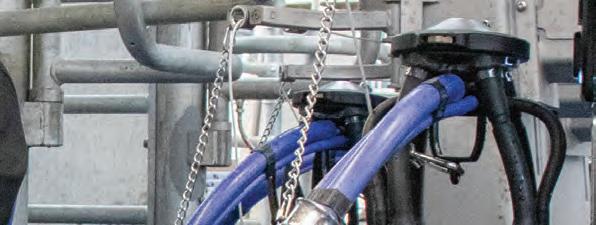
FONTERRA TOOK home 32 medals at the 2023 Dairy Industry Association of Australia Australian Dairy Product Awards, with Fonterra’s Stanhope site winning three gold and two silver for its products, including mozzarella, cheddar and parmesan.
The Stanhope team, in northern Victoria, also walked away with trophies for highest overall score for its cheddar cheese and the highest scoring mild/semi-matured and consumer pack cheddar cheese, which it also won last year.
These awards follow Fonterra Stanhope’s recent win at the DIAA Victoria Awards earlier this month, where it also took home gold for its cheddar cheese varieties.
Fonterra north regional operations manager Steve Taylor said Fonterra was honoured that its cheese had again be recognised as the best of the best in the industry.




“We take immense pride in the dairy products we make here at Stanhope, and this sentiment resonates with our farmers and our community,” Mr Taylor said.
“The key to crafting great cheese is simple, well cared for cows and high-quality milk sourced from our farmers in northern Victoria, coupled with the world-class dairy expertise we have here at our site.
“These awards are a fantastic recognition of this, as well as the hard work and dedication from our farmers, as well as our team at Stanhope and across Fonterra.”
Over the years, Fonterra Stanhope has won many awards for its cheese, so it is no surprise

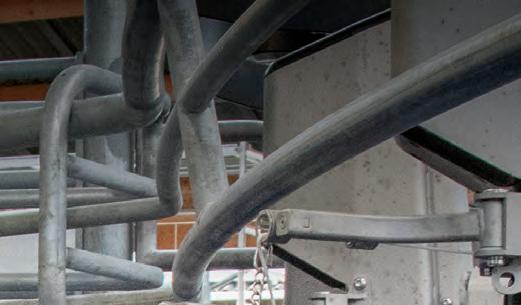



Stanhope is called the “Town of the Tastiest Cheese”.
From cheddar and parmesan to ricotta and romano, and even gouda and mozzarella, the site creates a wide range of cheese varieties.
It is also home to the number one culinary cheese brand in Australia, Perfect Italiano, which is found in almost one in two Aussie households.
The DIAA awards are a pathway to the










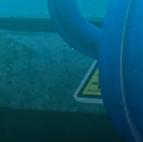






prestigious Australian Grand Dairy Awards held later in the year.


Expert judges, renowned for their dairy product expertise, evaluate entries based on their exceptional technical merit.




// 21 DAIRY NEWS AUSTRALIA JUNE 2023 NEWS With our new E-Series Hybrid Rotaries you can milk safely and efficiently with one operator. IS I T T I M E TO Upgrade Specialists Talk to the 1800 817 199 delaval.com MILK SOLO?
Fonterra north regional operations manager Steve Taylor said it was an honour to have the Stanhope factory’s cheese recognised as the best of the best in the industry.
Study looks at methane reduction
AGRICULTURE
VICTORIA
and an Australian agriculture company are set to test whether higher doses of a biological feed supplement will lead to a greater reduction in methane emissions and improve productivity in lambs and dairy cows.
Scientists from Agriculture Victoria recently published a 2021 study which showed 10ml of Terragen’s probiotic feed supplement, Mylo, reduced the intensity of methane emissions in dairy cows by more than seven per cent after 35 days.
Agriculture Victoria research director in animal production sciences Professor Joe Jacobs said the reduction in methane was “a good starting point”.
“We are interested in seeing if reductions in methane can be improved further,” Prof Jacobs said.

“One option is to feed the existing liquid formulation at a higher rate and see if further mitigation effects are possible.
“The second is to develop a stable dry formulation that can be activated just before or when feeding.”
Prof Jacobs said Agriculture Victoria wanted a greater understanding of whether supplementing the feed for lactating dairy cows or growing lambs with Mylo improved overall animal performance while reducing the animal’s methane emissions when compared to a supplement that did not contain Mylo.
“The study undertaken in 2021 was the first study in this recent program of research, noting Agriculture Victoria has a long history in
methane mitigation work, having previously investigated a range of by-products and common supple ments for their mitigation potential,” he said.
“In fact, key research findings from Ellinbank on feeding fat to dairy cows to reduce enteric methane production underpins one of the only two validated emissions reduction methodologies available for the dairy industry.”
Terragen chief operations officer Joss West said since any ruminant could produce methane, exploring further reductions in methane in a wider range of animals was “a great opportunity”.
“Our team is eager for Mylo to be studied using lambs at Hamilton in western Victoria, and dairy cows — again at Australia’s preeminent dairy research facility, the Victorian Government Ellinbank SmartFarm in Gippsland,” Dr West said.

“We will test whether elevated doses of our Mylo reduce methane production in lambs and lead to further reductions in methane in dairy cows.”
The probiotic, which uses a proprietary blend of three Lactobacillus strains, water and molasses, was shown to lift milk production, improve feed conversion efficiency and put weight on cows.
Meanwhile, a peer-reviewed University of Queensland study from 2018 showed calves on Mylo grew eight per cent more quickly than animals not supplemented with the liquid product.
Dr West said when most people thought of
methane in the agricultural sphere, they pictured emissions only coming from cows, but any ruminant animal could produce methane from feed fermenting in their rumen.
“The amount of methane a ruminant animal produces can often be attributed to its diet,” she said.
The lamb study aims to feed controlled amounts of Terragen’s supplement to around 200 individual prime lambs while grazing in pasture.

“It’s hoped Mylo will produce higher growth rates, a heavier carcase weight, improve feed conversion efficiency, reduce methane emissions, and result in reduced methane intensity per kg of lamb produced from each hectare of pasture,” she said.
Meanwhile in the dairy element of the study, a treated group will consume a significantly elevated dose of Mylo.
As part of the Methane Emissions Reductions in Livestock scheme, the Federal Government is providing $615,000 for Agriculture Victoria’s upcoming study on Mylo, while Terragen and New Zealand dairy giant Fonterra have also contributed to the cost.
Dr West said more than 60,000 dairy cows that are on Mylo in Australia each day would equate to more than 17,000 tonnes in carbon dioxide equivalent emissions not entering the atmosphere over one year, with the methane instead converting into energy for the animal.
22 // DAIRY NEWS AUSTRALIA JUNE 2023 NEWS SELECTIVE BREEDING PAVES THE WAY TO RECEIVE YOUR CHOICE OF FREE WWS DRINKWEAR WITH EVERY 100 UNITS OF WWS SEXED OR PREMIUM BEEF SEMEN SUSTAINABILITY ON FARM ® HERE FOR YOU. WORLD WIDE SIRES Phone (03) 5831 5559 • info@wwsaustralia.com wwsaustralia.com Product of the USA WHILE STOCKS LAST CAPPED AT FIVE UNITS OF MERCHANDISE PER ENTERPRISE ™gender SELECTED is a trademark of Select Sires Inc. Ultraplus™ is a trademark of STGen LLC. All gender SELECTED semen is processed using Ultraplus™ technology. Cow photo at M & W Fraser Gloucester NSW photo by Amy Wright NAMENEW RRP SPECIALHIGHLIGHTS 507HO14694 BANJO-P-XY $55 $50 Bighit-P x Heisenberg x Massey A2A2 BB High BPI bull with +449 with great strength traits; 107 chest width 550HO15208 LOGISTICS-XY $55 $50 Renegade x Helix x Delta One of Renegade’s highest Type sons with 2.21 PTAT and 2.01 UDC An elite semen conception rate bull with a +2.0 SCR and +1.0 DPR 507HO15523 PARSLY-XY $60 $55 Town x Delta-Lambda x Denver A2A2 BB Brother to the super popular PARFECT Great production with over 1500 Milk and 140 CFP 614HO15929 CIRRUS-P-XY $70 $65 Parfect x Kenobi x Delta A2A2 BB One of the most complete bulls on the market with Production, Health Traits, Type, Strength, Polled and +442 BPI 507JE01726 STARLORD-XY $60 $55 Craze x JX Pflex {5} x Determinate Top 5 BPI bull at +381 with 108 Likability, 105 Temperament & 103 Milking Speed. Early milking daughters are receiving outstanding reports from farmers. JSN Q06 ACHIEVER $25 $16 Great calving ease and semen fertility SPECKLE PARK sire 9AN00578 AUGUSTUS $16 $16 Proven calving ease and growth ANGUS sire
Terragen chief operations officer Joss West.
Bulla leads pricing
BY GEOFF ADAMS
MELBOURNE PROCESSOR Bulla Dairy Foods kicked off the milk pricing competition in mid-May, with price bands set between $8.80 and $9.60/kg milk solids.
The range is higher than the company opened with last season.
Under the national dairy code, introduced three years ago, all processors must publish standard forms of milk supply agreements on their website before 2pm on June 1.
Dairy and procurement general manager Rohan Davies said with the current economic climate showing so much volatility and uncertainty, he believed they had opened with a strong and market-relevant opening price for the season ahead.


“Our team has been forecasting and planning for the upcoming milk season for some time, taking into account current market conditions.
“This has put pressure on our business like many businesses in our industry and wider and has been a factor in our planning for the season ahead.”


He said this was a starting position and as business progressed, they would make necessary adjustments to the price.


Bulla Dairy Foods began last season with most suppliers in the $8.70 to $8.90/kg MS range.




Fresh Agenda dairy consultants have forecast a full-season milk price paid to southern producers, expected to average $8.50/kg MS in 2023-24 based on projected commodity prices, average manufacturing conversion costs and the industry product mix.




In the March 2023 Situation and Outlook Report, Dairy Australia forecasts a contraction of between four to six per cent in the Australian milk pool this season, due to worker shortages, competition for land and resources and wet weather conditions.
While milk production may be contracting, Australian dairy’s commodity prices are strong compared with other exporting countries, helping insulate the industry from some of the pressures emerging overseas, according to the report.
Global commodity values have dropped, along with international demand for dairy.
“The level of dairy product available for export globally is growing, as production in other countries outweighs local demand,” Dairy Australia’s industry analyst Eliza Redfern said.

– More on pricing, pages 24-26.
 Bulla Dairy Foods has kicked off the milk pricing competition, with price bands set between $8.80 and $9.60/kg milk solids.
Bulla Dairy Foods has kicked off the milk pricing competition, with price bands set between $8.80 and $9.60/kg milk solids.
// 23 DAIRY NEWS AUSTRALIA JUNE 2023 NEWS Heat and health monitoring you can trust Get Tru-Test Active Tag working for you Work smarter Uncompromised heat detection Better health management Let's talk. Rodney Brooks 0408 741034 TruTest@genaust.com.au dairy.farmingmadebetter.com 24/7 support available every step of the way Feedomatics endless feed troughs come in 8 and 6m lengths. They are made from Australian steel and re-purposed nylon rubber. They are stackable for ease of movement. 8m $1650 INC GST • 6m $1240 INC GST. Call Grant Today! Stop Wasting Feedworking to save you time and money! For more information Phone: 0428 106 132 www.feedomatic.com.au
Prices set for
AUSTRALIAN DAIRY producers can look forward to another favourable season in 202324, with the sector set for its fourth consecutive profitable year, Rabobank says in its annual Australian Dairy Seasonal Outlook released in May.
The agribusiness banking specialist says while the upcoming season’s milk price will likely be lower than the “lofty highs” currently
Every generation. Better.
being offered across parts of the southern export region — reflecting the current downturn in the global commodity price cycle — there is a “firm landing zone” expected for new season Australian milk prices.
This is due to stronger domestic dairy market returns, a weak Australian dollar and “aggressive recruitment and retention strategies” by dairy processors in a competitive market for milk supply.




And these are providing a buffering effect to the full extent of global pressures, according to report author, Rabobank senior dairy analyst Michael Harvey.

Ahead of the June 1 deadline for minimum milk price offers from Australian dairy companies, the bank was forecasting minimum offers for new season milk in southern Australia to be between $8.50/kgMS and AUD $9/kgMS.
“At worst, this represents a 10 per cent decrease from 2022-23 prices and a farm gate milk price that is well above the medium-term average for southern Australia since the introduction of the industry’s Dairy Code ofConduct in January 2020,” Mr Harvey said.

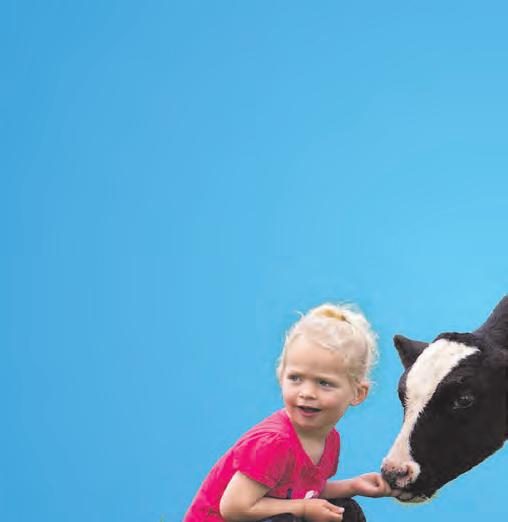
“Another season of historically-elevated milk prices will support farm gate margins.”
Cost relief
The report — titled Looking for a Firm Landing Zone — says there is “welcome relief” for dairy farmers from a recent record-high cost base, with lower prices for purchased feed and fertiliser flowing through balance sheets.
“Even if some dairy farmers see an easing in minimum price offers, this should come with cost relief,” Mr Harvey said.

He said global feed benchmark prices were down compared with last year, although still above medium-term averages, while local wheat prices were tracking close to global trends.
“Locally, grain supplies are high, after several bumper winter crops, with the prospect of another decent winter crop this year, meaning feed supply will be adequate for buyers and will help to dampen feed supply risks.”
Mr Harvey said Australian dairy farmers would already be seeing the benefits of a significant correction in global fertiliser prices and, therefore, a boost in affordability.
“Looking forward, Rabobank expects the underlying fundamentals in the fertiliser market to lead a period of price stability, which will assist Australian dairy farmers as they prepare their nutrient management programs for the year ahead.”


However, the Rabobank Outlook warns, there will still be other cost headwinds on farm in 2023-24 — including higher interest rates — and “labour is a major headache”.
“Despite the relief on purchased and home-grown feed costs, as Australian dairy farmers begin budgeting for the year ahead, they will still have to deal with a high-costof- production environment in the 202324 season, as inflationary pressures flow through in overhead costs, particularly the cost — and availability — of labour,” Mr Harvey said.
“At the same time, interest rates are moving higher.”

Global dairy outlook
The report says milk prices in a number of dairy-exporting regions around the world have already fallen, following the large decline in global dairy commodity prices seen since their peak in the first half of 2022.
24 // DAIRY NEWS AUSTRALIA JUNE 2023 NEWS
Our farms and our future depend on us farming smarter. Cows that can generate more milk, more efficiently. Cows that can better utilize nutrients with lower nitrogen and methane outputs. LIC’s pasture-based genetics offering can help you accelerate your rates of genetic gain. While our sexed semen provides you with a 90% chance of generating heifer replacements from your best cows. Talk to your District Manager today about farming smarter for the next generation. 1800 454 694 | admin@licaus.com.au | www.licnz.com.au There's always room for improvement
for a ‘ rm landing zone’
“Since that time, prices in the ‘dairy commodity basket’ have fallen significantly on the back of a shift in underlying fundamentals in the market,” Mr Harvey said.
These included a return to growth in milk supply across most dairy-exporting regions (coupled with softer domestic demand), sluggish import appetite from the world’s largest dairy importer China and widespread demand “rationing” in many dairy markets across retail, food service and ingredient channels.
As a result, Mr Harvey said, “indicative stream returns” for Australia’s dairy product mix had fallen between 30 and 40 per cent compared with the same time last year and are now at, or below, average returns of the previous five years.
Rabobank says “near-term global fundamentals” — including increasing growth in milk production in export regions through 2023 and “largely absent” Chinese buyers until the second half of the year — will keep downward pressure on global dairy commodity prices.
“However, at some stage the cycle will turn and global commodity prices will begin to increase, but this will depend on when China returns as a meaningful buyer in export markets,” Mr Harvey said.
Domestic market
Locally though, Australia’s domestic market returns have reset for the better, the report says.
“The domestic market is experiencing a structural increase in consumer prices across the dairy aisle,” Mr Harvey said, “led by drinking milk and cheese in particular.
“This is driven by dairy processors passing through record-high farm gate prices and other input costs.

“This is important as it will support the valuechain and lead to stable farm gate milk prices over multiple seasons for those milk producers supplying the domestic market.”
Local supply
Australia’s dairy supply chain continues to be challenged by a declining milk pool, Rabobank says.
In 2022-23, the annual availability of milk for manufacturing will fall below six billion litres, for the first time since 1990, the report says.
Investment
The Rabobank Outlook says consecutive seasons of farm sector profitability and industry stability are providing dairy producers with an opportunity to rethink their longer-term investment strategies.
“There has been a notable pick up in investment to increase labour efficiency and improve capacity,” Mr Harvey said.
Processors’ point of view, page 26 The
UNLOCK THE BENEFITS
TEAT SEALANT


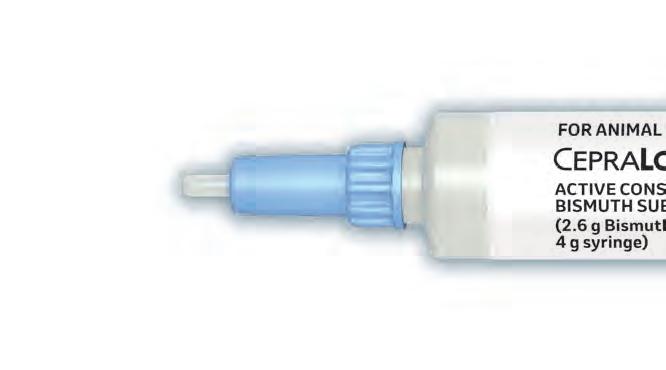
set
// 25 DAIRY NEWS AUSTRALIA JUNE 2023 NEWS 1. S McDougall, 2003. Management factors associated with the incidence of clinical mastitis over the non-lactation period and bulk tank somatic cell count during the subsequent lactation, New Zealand Veterinary Journal, 51:2, 63-72. 2. Boddie & Nickerson, 1986. Dry Cow Therapy, Effects of Method of Drug Administration on Occurrence of Intramammary Infection, J. Dairy Sci 69, 253-257. ® Registered trademarks. Intervet Australia Pty Ltd (known as MSD Animal Health). ABN: 79008467034. Copyright © 2023 Merck & Co., Inc., Rahway, NJ, USA and its affiliates. All rights reserved.
–
cost and availability of labour continues to cause headaches for the industry, says Rabobank
Flexible dual tip syringe for greater precision to help reduce mastitis infections1,2 Smaller air pocket and shorter plunger for smoother and faster application Designed, manufactured, and supported by MSD Available from your local Veterinarian For more information on Cepralock, contact Clive Schwikkard on 0409 036 544 EVERY COW DESERVES A TEAT SEALANT
OF CEPRALOCK®
Challenges ahead for new season
NATIONAL ADVOCACY body for the post farm gate members of the Australian dairy supply chain, the Australian Dairy Products Federation, says it fears for the dairy manufacturing sector’s sustainability.
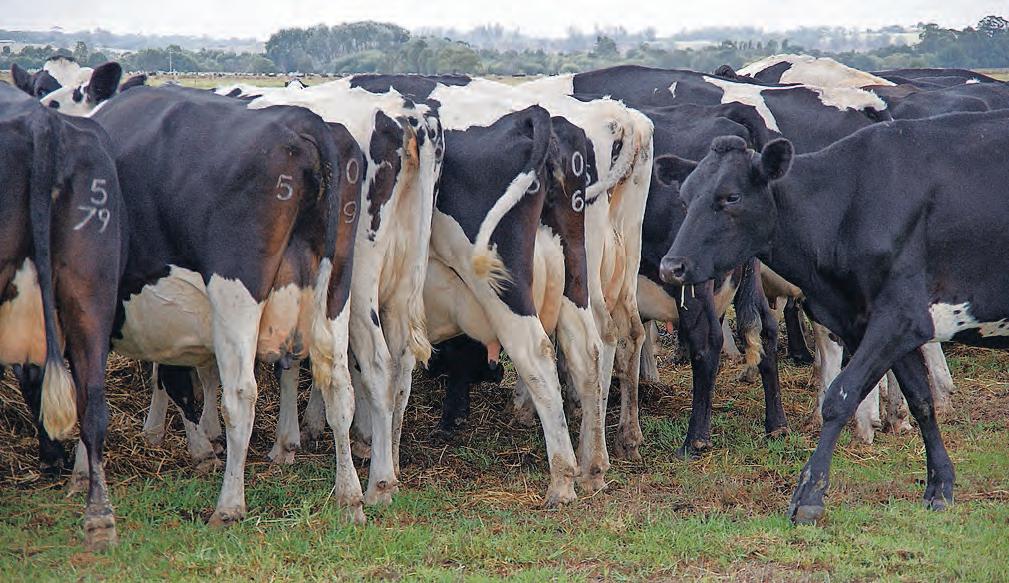
It says a year ago it cautioned that the then unprecedented record farm gate milk prices that were on offer were going to place enormous pressures on dairy manufacturers.
In mid-May, ahead of the 2023-24 milk season opening, it says the volatile global markets, challenging local conditions, and inflationary pressures have grown.
According to the industry’s Milk Value Portal, as of May 15, 2023 the Oceania (NZ export) Commodity Milk Value — and a forward milk price indicator of how the global market may affect dairy product prices in coming months — has dropped around 30 per cent to $6.49/kgMS since June 6, 2022 ($9.15/kgMS), compared to the weighted average announced southern region farm gate milk price for the 2022-23 season of $9.60/kgMS.
The Australian Wholesale CMV has dropped 17 per cent during this same time, to $8.25/ kgMS (versus $9.99/kgMS, June 6, 2022).

ADPF executive chair John Williams said the current operating conditions for manufacturers were tough and needed to be countered so Australian regional jobs and economies were not hit hard if processors were forced to rationalise their operations.
“In the lead up to the new milk season, on top of the decline in global prices, Australian dairy processors are contending with low
volume growth, exorbitant overhead and input costs (inclusive of energy, transport and raw milk), a tough and highly competitive domestic trading environment, and rapid growth in import competition,” Mr Williams said.
“For example, year-to-date (February 2023), the volume of imports from New Zealand are up 22 per cent and imports from the US are up 46 per cent.
“Further, the current 20 per cent higher farm gate milk prices being paid in Australia compared to NZ, places Australia at a competitive disadvantage not only in export markets, but it is also
being reflected on our supermarket shelves with NZ made cheese and butter priced significantly cheaper than Australian made products.”
He said despite inflation related cost of living pressures, encouragingly the demand for nutritious dairy products continued.
“However, to participate as a viable supplier to meet this demand and provide confidence in the security of Australian manufactured products to our customers, we need more of that core ingredient of ‘raw milk’ and this currently is a leading challenge for the Australian dairy sector,” Mr Williams said.
Australia’s year-on-year national raw milk production volumes are decreasing, down to 8.5 billion litres in 2021-22, and forecast to fall slightly below eight billion litres for the 2022-23 season or a further six per cent drop compared to the 2021-22 season.
He said this downward trend was forecast to continue in the 2023-24 season, falling a further three to four per cent to 7.8 billion litres.

“Australia is home to some of the world’s most advanced and modern milk processing technology available, but without confidence current milk production trends will turn the right way, the Australian dairy processing industry will have to make decisions to reduce capacity and capability,” Mr Williams said.
From June 1, 2023, Australia’s dairy farmers have a month to assess farm gate milk price offers and contract terms from processors as the annual 2023-24 milk season opens.
Under the Australian Competition and Consumer Commission Dairy Code of Conduct implemented in January 2020, buyers of raw milk are obligated to complete and make publicly available Milk Supply Agreements by June 1, including milk price.
This requirement is unique to Australia — no other commodity market in the world requires processors to announce farm gate milk prices 13 months out from the season’s end.
This risked processors’ viability in a market where the costs of Australian products were not competitive with imports, according to the ADPF.
STRENGTH THAT MATTERS
MILCast design, manufacture and supply precast concrete products for agricultural and commerical uses.
PRECAST PRODUCTS

We design, manufacture and supply precast concrete products for agricultural and commercial uses. To view our full product range visit the shop.

CORPORATE ORDERS
MILCast have the capacity to manufacture and supply bulk products to corporate customers. Products can be from our existing catalogue or made-to-order.
MILCast not only supplies to local landholders and businesses, but also assists large scale projects afar.

The MILCast team can design made-to-order structures based on your specific needs, including pipe brand selection and control door requirements.
MILCast can design made-toorder structures based on your specific needs, including pipe brand selection and control door requirements.
26 // DAIRY NEWS AUSTRALIA JUNE 2023 NEWS
The supply of raw milk is a leading challenge for the Australian dairy processing sector, says the Australian Dairy Products Federation.
MILCast Australia is a Gradian Group Company. MADE-TO-ORDER Delivery options are available Contact our team of experts: 03 5888 3051 sales@milcast.com.au www.milcast.com.au
VFF appoints new leader
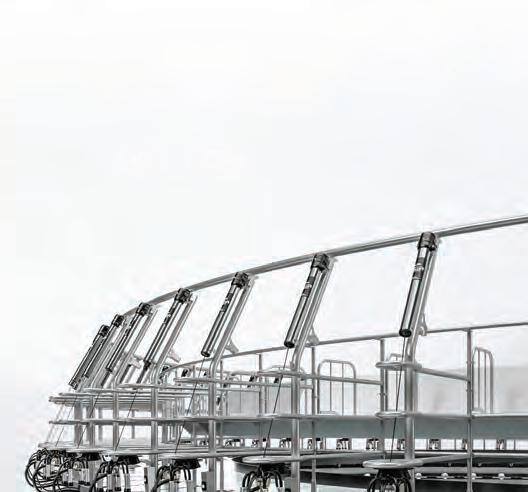
BRENDAN TATHAM has been appointed chief executive officer of the VFF.
Mr Tatham joined the organisation as VFF Interim CEO in November 2022 and was successful following an extensive recruitment process which attracted a large pool of applicants conducted by Pacific Search Partners.


VFF president Emma Germano said she was delighted to announce the appointment of Mr Tatham and the significant experience and knowledge that he would continue to share with the organisation.
“Brendan brings over 25 years of experience to the VFF from his extensive background in public health, agri-food and emergency management, having held senior leadership positions at the Victorian Department of Environment and Primary Industries and as chief executive officer at PrimeSafe,” she said.



“Since taking the reigns as VFF Interim CEO in late 2022, he has helped fast-track the transformation of the VFF.

“His permanent appointment will better enable the organisation to deliver the best possible results for farmers; exactly what we need to do.”
Mr Tatham said he was eager to continue the work that has been started to allow the organisation to embrace the opportunities of the future.
“I’m thrilled and honoured to be asked to lead the VFF,” he said.










“I’m genuinely excited about the opportunity to work with the board, staff and members to make a difference for Victoria’s agricultural industries, farmers and regional communities.
“Farmers are at the core of everything we do, and I look forward to transforming our members’ needs into outcomes by utilising the fast-moving media, technology and political cycles that make up today’s modern advocacy environment.”
// 27 DAIRY NEWS AUSTRALIA JUNE 2023 NEWS LEADING EDGE NUTRITIONAL ADVICE AND ON-FARM SUPPORT Achieve sustainable improvements in your herd’s performance by talking to the specialists. Call our experts today on 1300 666 657 or email enquiries@ridley.com.au www.ridley.com.au FEED SMART RID24750
New VFF chief executive officer Brendan Tatham.
Aussie farmland price hike

THE COST of Australian farm land continues to increase with prices up 20 per cent in the past 12 months, marking a ninth consecutive year of growth.

The latest data from Rural Bank shows the price of agricultural land has risen 167 per cent since 2014, fuelled by strong demand and increasingly tight supply.
“Farmland values maintained strong growth momentum in 2022 as the national median price per hectare increased by 20 per cent to $8506 per hectare,” Rural Bank’s Andrew Smith said.

The data showed 2022 as the first time in almost three decades that growth of more than 15 per cent was recorded across all states and territories.
But that growth is expected to slow down in the next 12 months.
“The likelihood of lower farm incomes in 2023 has the potential to cause prospective buyers to reassess their purchasing intentions and consequently lead to a shallower pool of buyers,” the report said.
“We do expect this current year to still see growth but not at the same level,” Mr Smith said.
Some of the biggest price hikes were seen in Tasmania where on average buyers paid 55 per cent more per hectare for agricultural land last year.

“I think what we had found with Tasmania is that it was coming off a lower base historically,” Mr Smith said.




Victoria, South Australia and Western Australia all had prices increase by more than

20 per cent on the previous year.

The Northern Territory recorded 108 per cent growth, but Mr Smith said the figures tended to be skewed because of the small number of sales.
Queensland also recorded a big increase in the price of land and took out the title for the most land bought and sold with 2,497,556 hectares traded.
“We’ve seen some strong sales in Queensland with just under two-and-a-half million hectares of land traded, and the price was up 19 per cent for the year,” Mr Smith said.

He said farming families were behind the purchases.
“We’ve seen a number of larger businesses aggregating their holdings,” Mr Smith said.

The report found the farmland market continued to experience growth at a time when the residential sector had slowed down.
“The national average price of residential dwellings fell 5.3 per cent across the year following growth of 25 per cent in 2021,” the report said.
But while farmland values were up in 2022 there were far fewer sales nationally, with the number of transactions down by 34 per cent to 6588.
The report concluded 8.8 million hectares of land was bought and sold last year, worth a combined value of $11.7 billion.
“The total number of hectares of Australian farmland sold in 2022 equates to an area similar in size to that of a European country, such as Hungary,” Mr Smith said.




28 // DAIRY NEWS AUSTRALIA JUNE 2023 NEWS Call 1300 736 848 or visit CLARKFARMEQUIPMENT.COM.AU Agricultural Equipment
SCAN
In Tasmania, on average buyers paid 55 per cent more per hectare for agricultural land last year.
Catalogue
TO DOWNLOAD
Building resilience in calves
CALF REARING can be a huge challenge and drain on a farm’s resources, even when things go to plan.
Sick calves not only place pressure on the farms immediate resources, but can potentially affect long-term growth and productivity of replacement heifers.
Nicole Saunders can relate, with expectations of rearing 700 calves this year across three properties at Maffra in Victoria.
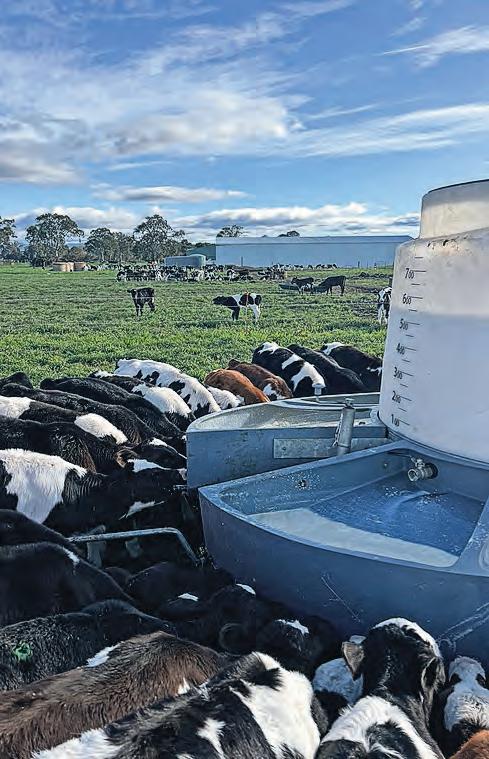
“Calf illness outbreaks are a massive drain on farm resources in many ways, but the largest drain is on your mental health,” she said.
“No-one likes illness and death, it drains everyone, as we are all trying our hardest to look after our animals to the highest possible standard we can.
“I don’t think I could even quantify the drain of outbreaks on our labour and mental resources.”

Ingredients for success
Nicole and husband Brendan currently run 1600 milking cows across three properties totalling 780 hectares with the entire herd calving in spring.
Last year Nicole was recommended to try a new additive in her milk, to focus on building the calves resilience and reducing the impact of potential health issues such as scours and salmonella.
“Last season we determined our main cause of death in calves was salmonella,” Nicole said.
“However, we purchased a significant amount of cows that season, so vaccinating wasn’t really an option as we didn’t have the opportunity for the right time intervals of the vaccine and didn’t know if the salmonella strain would be the same as the previous season.”
“So, I talked to our local vet for other recommendations, and she mentioned Celmanax.
“We added Celmanax to the milk at the recommended rate for the first 60 days of life, including the first colostrum feed.
During periods when calves were challenged, we simply doubled the daily dosage rate per head used.
“To ensure Celmanax was mixed consistently, we used a protein shaker to mix it with some milk prior to adding it into the main milk feeder.”
Reducing the incidence and impact of calf diseases
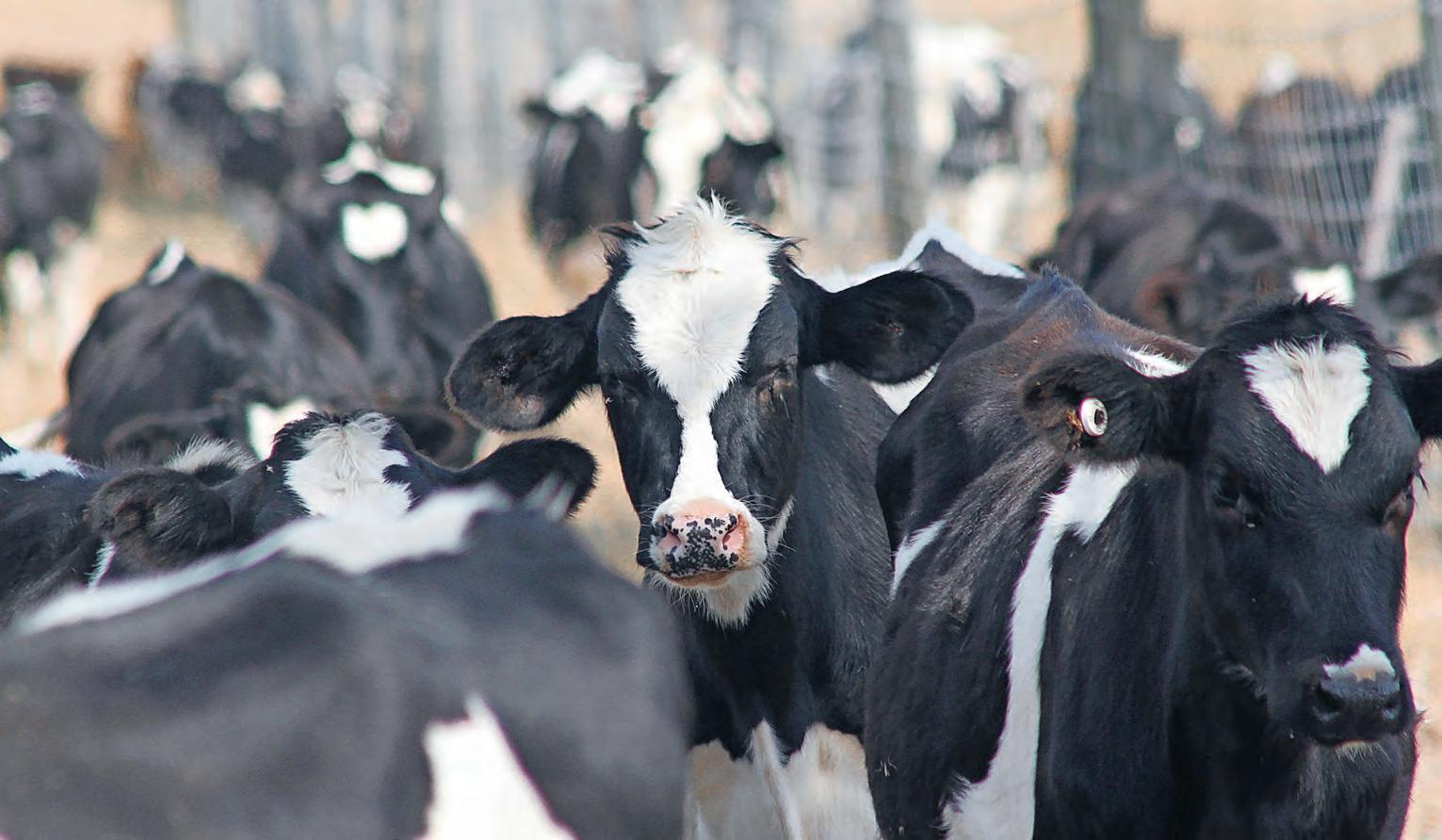
Celmanax is widely used in commercial CMR, whole milk boosters and calf starter rations to
reduce the incidence, duration and severity of salmonella, E. coli and crypto infection.
It has also been shown to improve weight gain and productivity during periods of heat stress.
“We previously used a probiotic additive product for the milk, which we did see good results with but was very expensive compared to Celmanax,” Nicole said.
“I think we saw better results with Celmanax and it definitely outperformed in instances of salmonella outbreaks; you could see improvements in calves within 24 hours.
“This season we will be using a probiotic paste at birth and during times of stress and adding Celmanax to the milk including colostrum from birth through to 60 days old.
“We found Celmanax is best used as a prevention, it is not a cure, but it helps calves that are in the very first stages of illness and reduces the amount that need to go on for further medication and treatment.”
Setting up calves for productivity at first lactation
Celmanax is distributed in Australia by Auspac
Ingredients. It’s efficacy is supported by numerous trials.

In one study, calves receiving Celmanax supplementation in the milk replacer had reduced pathogenic E. coli shedding and a trend for higher body weight. When followed through their first lactation, these calves produced 195kg more milk, 13kg more fat and 8kg more protein compared to calves fed control milk replacer.
Optimising lifetime feed efficiency
What makes Celmanax so effective is it provides multiple products in one consistent formula.
“Celmanax has definitely lived up to expectations and we will be using it across our entire operation this season,” Nicole said.
“I would recommend it, as compared to other products it is far more cost effective, so would be great for someone who has been hesitant to use a milk additive due to the price barrier until now, and for us, it has outperformed other products.
“Although I haven’t done the research yet, considering the impact it has had on the calves, it could also be useful within the main milking herd.”
H Calf coats provide the extra warmth to help your calves survive harsh weather conditions.

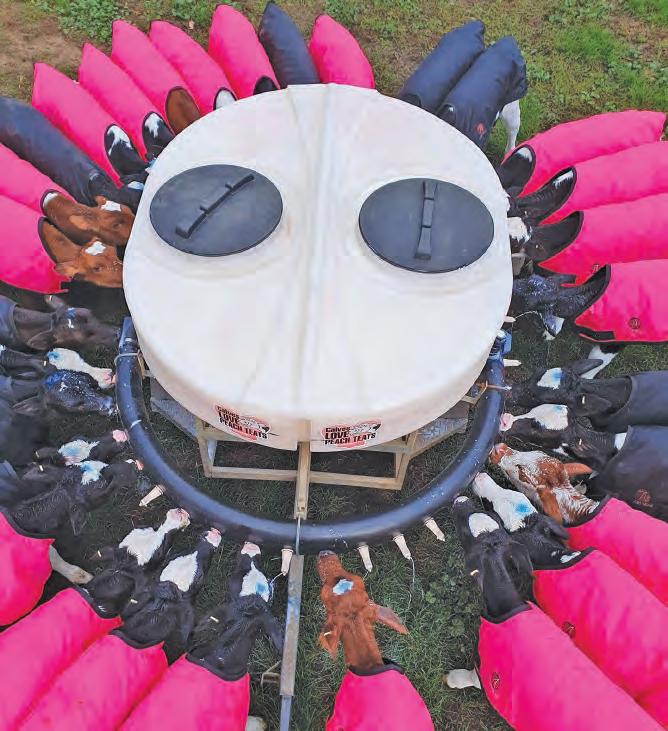
H Breathable and water-proof with a quilted inner lining.
H Available in three sizes.
H Machine washable.
H Easy to put on and take off –Velcro closure on the front and buckle leg straps.
A vet recommended Celmanax to the Saunders to help reduce the impact of potential health issues such as scours and salmonella.
// 29 DAIRY NEWS AUSTRALIA JUNE 2023 CALF REARING PROTECT YOUR CALVES FROM THE BITTER COLDWITH CALF COATS!
Nicole Saunders and husband Brendan currently run 1600 milking cows across three properties totalling 780 hectares with the entire herd calving in spring.
Agri-Gene Pty Ltd 123-125 Tone Road, Wangaratta Victoria 3677 Ph: 03 5722 2666 Fax: 03 5722 2777 Email: info@agrigene.com.au www.agrigene.com.au
Dedicated to healthy calves
EffectofOrego-Stimon CryptosporidiainDairyCalves
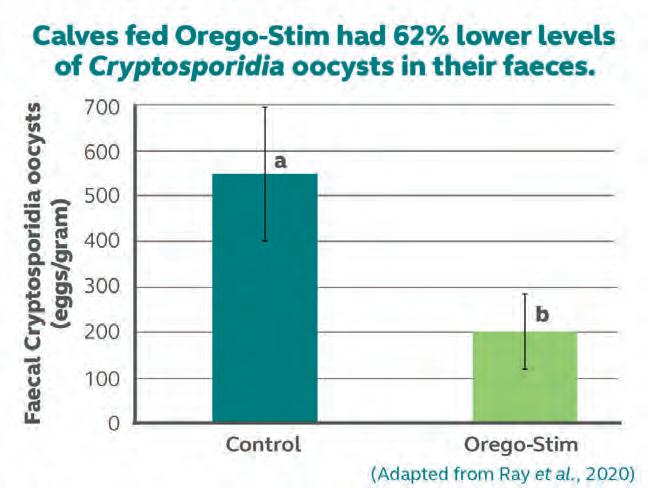
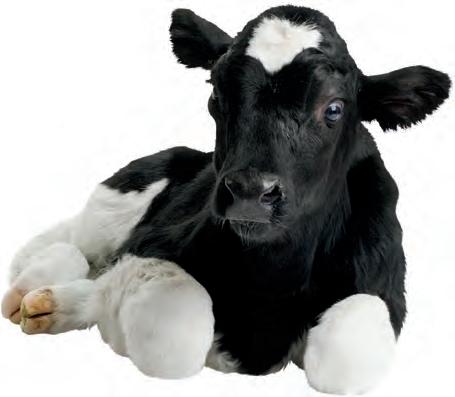
Arecenttrialreported:

62%
100+ActiveCompunds
Anti-oxidant
Anit-bacterial Anti-inflammatory
CalvesfedOrego-Stimhad62%lowerlevels ofCryptosporidiaoocystsintheirfaeces.
BY SOPHIE BALDWIN
WHILE EVERY dairy farmer knows the importance of raising healthy calves, owning one of the top Holstein herds in Australia adds an extra element to ensure things are done just right.
For Glen and Drew Gordon from Gorbro Holsteins at Cohuna, this has meant investing some pretty big bucks into a purpose-built shed, along with employing dedicated staff member Kelly Bleijendaal, whose sole job is to manage the calves and the show cows.
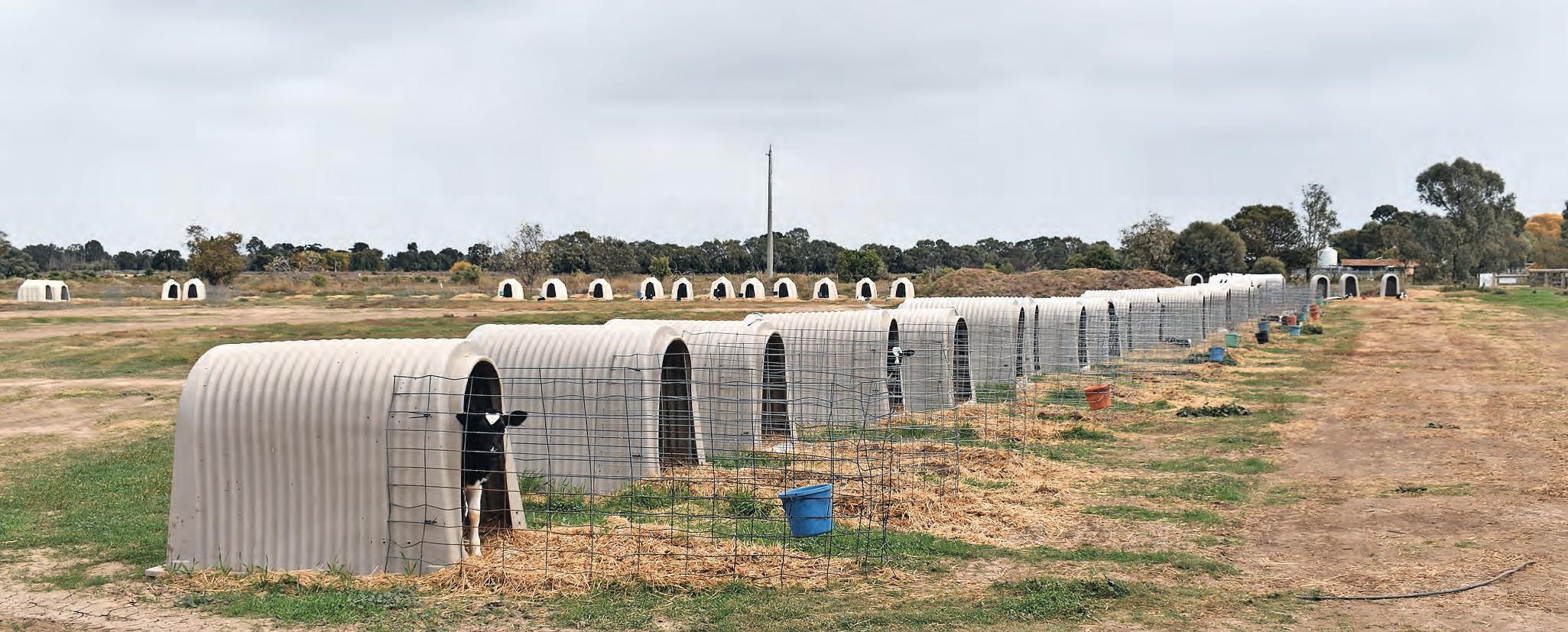
“Drew used to feed the calves before Kelly and he did a great job but it was always in the back of his mind what was the next job to rush too, now Kelly can focus on the calves and it doesn’t matter how long it takes to feed them each day, we trust her to do the job well,” Glen said.
The new shed is 112m long and 22.5m wide.
It is part one of a significant on-farm infrastructure development which will eventually see the completion in October of an 750-head, free stall barn.
The calf shed is orientated east/west with a skillion roof to make the most of the northern Victorian climate — sun in winter and shade in summer. It has also been constructed to be dual purpose and house the show team.
The shed is capable of holding up to 250 calves and includes a cemented wet area up one end of the pen where the grain and milk is fed. The hay feeder is situated away from the wet area and up the opposite end of the pen for easy filling.
The calves are bedded on a concrete floor with straw for comfort, in pens of eight.
The simple design enables calves to be easily moved between pens if required and perhaps even more importantly for cleaning.
Once a pen of calves is moved the gates are opened and the bedding is scraped out, the pen cleaned and disinfected and readied for the next batch.
Scanfor brochure
Calves(birthtoweaning):10mlperheadperdaymixedinto themilkforupto10days,then2mlperdayuntilweaning.
Visitourwebsitetoorderortofindalocalstockist
www.anpario.com.au0294777944
The calves are moved into the calf shed after spending the first three weeks individually housed in hutches.
Each hutch is pressure washed and placed on a greenfield sight with clean bedding before a calf moves in.
Glen and Drew have been managing their newborns in hutches for the past six years because they believe it reduces the spread of sickness and allows them to focus on giving each calf the best possible start.
Being portable, they can also move the hutches to different locations.
Kelly said it took about an hour to get around and feed all the calves in the hutches and then she moves onto the main shed.
A game changer for the calf rearing system has been the purchase of a Daviesway milk taxi.
The taxi heats the milk up to 39°C and disburses it straight into the 20 litre troughs without having to measure a single litre of milk or lift a heavy bucket.
Kelly said the main reason she moved to Gorbro was because of the family’s focus on animal health and welfare.

“It is extremely important to me how people treat their stock and there is certainly a real focus here to give every animal the best life possible — from calves through to show cows, it’s amazing,” Kelly said.
Kelly said the key to raising a healthy calf is to ensure an early drink of good quality colostrum.
“Colostrum management is high on the list here and we top up our fresh milk with Kwik Start, an artificial colostrum we put in the milk for added health benefits,” Kelly said.
Each newborn calf is given three bottles of colostrum.
Kelly also pays particular attention to every calf.
“Knowing your calves and their personalities means you pick up really quickly if they are getting sick,” she said.
Kelly estimates she has reared more than 1800 calves in the past couple of years.
“I have always loved working with young stock and even though I have been doing it full-time for the last two years, I still love it,” she said.
Kelly moved to Australia from the Netherlands, and while she didn’t grow up on a dairy farm, her love for cows was fostered by the dairy farmers next door.
“I think I was 12 when I first started going over there to see the cows,” Kelly said.
In 2019 Kelly came to Australia to stay for a few months, but COVID-19 soon put a stop to her returning and she has been working in Australia ever since.
Working with calves is just one of Kelly’s loves, the other is showing cattle, something she has been doing since she was 20 — she gets the best of both worlds at Gorbro.
Glen and Drew Gordon have been managing their newborns in hutches for the past six years because they believe it reduces the spread of sickness and allows them to focus on giving each calf the best possible start.
30 // DAIRY NEWS AUSTRALIA JUNE 2023 CALF REARING
It is extremely important to me how people treat their stock and there is certainly a real focus here to give every animal the best life possible — from calves through to show cows, it’s amazing.
Optimise lifetime feed conversion efficiency.
REDUCE PATHOGENIC BACTERIAL LOAD IMPROVE HEALTH
What if you could proactively improve calf and cow health sothey can better withstandchallenges, including those caused by mycotoxins?
What if you could control calf diarrhea before an outbreak, and reduce the incidence, severity and duration of other common diseases that affectthe feedconversion efficiency of lactating cows and your bottom line?

PROMOTE PRODUCTIVTY
What if you could add nutritional insurance to every stage of your cattle’s lives resulting in healthier heifer calves that join the milkingherd ready to contribute at a high level, and lactating cows that spend less time off feed.
Research demonstrates: CELMANAX

ONLY CELMANAX
Has been shown to:
•Agglutinates and binds E. coli and Salmonella enterica.
• Agglutinate and bind E. coli and Salmonella enterica
•Reduces the incidence, severity and duration of mastitis and cryptosporidiosis infection.

• Reduce the incidence, severity and duration of mastitis and cryptosporidiosis infection

• Reduce blood stress markers during and after transport and temperature stress.
•Reduces blood stress markers during and after transport and temperature stress.
• Minimise cytotoxic damage caused by a variety of mycotoxins and carryover of aflatoxins in milk
•Minimises cytotoxic damage caused by a variety of mycotoxins and carryover of aflatoxins in milk.
• Improve weight gains and performance in calves and milk yields in lactating cows

•Improves weight gains and performance in calves and milk yields in lactating cows.
Distributed By:
www.auspacingredients.com.au
Calf development supported
DEVELOPED TO manage intestinal health and support optimum gut integrity and performance, OREGO-STIM is a consistently high quality, 100 per cent natural oregano essential oil based feed additive.
It has been formulated to be low inclusion for inclusion in milk and calf starter diets, providing an effective, homogenous mix.

Natural OEO is proven to provide a multitude of benefits and properties which support calf development and lifetime performance, including:

appetite enhancement; anti-oxidant; immunomodulatory/anti-inflammatory; anti-microbial; and modulate gut microbiota.
Calf gut health importance


Gut health is vital in promoting optimal calf growth and enhancing lifetime performance. Healthy calves make more visits to milk and concentrate feeders than diseased calves.
Heavier calves at weaning, and those with a higher average daily gain from birth to weaning demonstrate a higher milk production during first lactation.
A greater ADG and bodyweight is also associated with improved fertility in heifers.
Calves fed OREGO-STIM have demonstrated the following benefits:

better feed intake;
better gut health; increased growth rates and greater weaning weights;
lower levels of Cryptosporidia oocysts in faeces; and reduced levels of antimicrobial resistant E. coli



Waste milk supplemented with OREGO-STIM: resulted in reduced levels of E. coli with antimicrobial resistance to fourth generation cephalosporins in the faeces; reduced levels of resistant E. coli to 12.6 per cent, compared to 44.1 per cent in the control group of calves; delayed the emergence of AMR to seven days, compared to emergence at three days in control-fed calves; beneficially altered the gut microbiome; and tended to reduce E. coli counts in the faeces. Benefits were maintained even after OREGO-STIM supplementation was stopped.
OREGO-STIM is derived from cultivars of Origanum vulgare spp. hirtum that are specific to Anpario.
Anpario’s oregano is grown using organic, pesticide-free principles. Testing is carried out prior to harvest, at oil extraction and final product to ensure uniformity of 35 compounds in every batch.
The main active components, carvacrol, ρ-cymene and thymol are established to have strong anti-microbial effects.
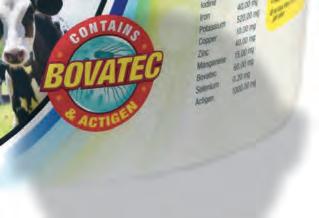

















Other compounds, such as β-caryophyllene have anti-inflammatory effects whilst γ −terpinene has strong anti-oxidant properties. OREGO-STIM is available in powder and liquid form.
For more information, visit: www.anpario. com.au or phone (02) 9477 7944.

32 // DAIRY NEWS AUSTRALIA JUNE 2023 CALF REARING A LIAN ED CON T AINS 8.5 KG
OREGO-STIM is derived from cultivars of Origanum vulgare spp. hirtum that are specific to Anpario.
Nutrition vital for conception
LOW REPRODUCTION continues to be a challenge in dairy production systems despite the advancement in genetic gain through breeding and selection for milk production.
The reason for low reproduction is multifaceted, but mainly associated with nutrition and overall management of the cow.
According to researchers from across the globe, both high and low producing cows are affected by low fertility.
So, with the right nutritional tools, it is possible to maintain high production and reproductive capacity in dairy herds.
Two nutrition-related factors are body condition and negative energy balance, both of which have significant impact on the reproductive performance of dairy cows.
Body condition and energy balance are closely linked.
A cow with good energy balance is likely to be in good body condition. Other factors that affect reproduction are not discussed in this article.
Around four weeks before and after calving (transition period), dairy cows’ energy requirements dramatically increase due to the increasing demand from the developing fetus and milk production while intake is still low.
To meet this increasing energy demand, the dairy cow mobilises its body reserve (mainly fat), and she gets into a physiological condition called negative energy balance.
While negative energy balance is a natural process, its severity can have a negative impact on cow health by increasing the risk of
metabolic disorders, reduce immune function and fertility.
Metabolic disorders during transition can reduce fertility because affected cows are seven to 10 per cent less likely to get pregnant.
Research has shown that negative energy balance negatively affects the development of ovarian function, resulting in a decrease in the proportion of follicles that can ovulate.
Energy is a major limiting nutrient in dairy cows and inadequate intake of energy can have detrimental effect on reproduction.
Cows in negative energy balance have low levels of insulin and a substance called insulin-like growth factor 1 (IGF-1), causing a delay in (or lack of) ovulation and the resumption of estrous.

A cow must ovulate to have a chance to become pregnant.


Increasing energy intake (or dry matter intake) can improve energy status of dairy cows and therefore, reproductive performance.


There is also strong evidence to suggest that inadequate intake of nutrients pre-calving can predispose dairy cows to impaired immune function; and, subsequently, increased risk for uterine diseases that negatively affect reproduction.
Some of these nutrients are important in various metabolic processes responsible for protein and glucose (energy) synthesis in the liver.
Example of such nutrients are B vitamins, which play significant roles in energy and protein metabolism in the liver and immune modulation.
Five B vitamins, including folic acid and B12, are involved in glucose production in the liver, and their supplementation can improve energy balance and subsequently increase the number of cows that conceived to first insemination (Figure one).
Supplementation with B vitamins also reduced metabolic disorders and subsequently improved fertility.
Genomic research also showed that certain genes responsible for follicle growth and development, resumption of estrus activity, and embryo survival, were switched-on when vitamins B12 and folic acid were supplemented in early lactation cows.
If cows conceive early and maintain pregnancy, they will produce more milk profitably.
Poor (skinny cow) and excessive (fatty cow) body condition are equally undesirable; both

Two nutrition-related factors are body condition and negative energy balance, both of which have




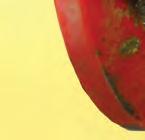
pose a high risk of low feed intake, increased metabolic disorders, and the subsequently low reproductive performance in dairy cows.

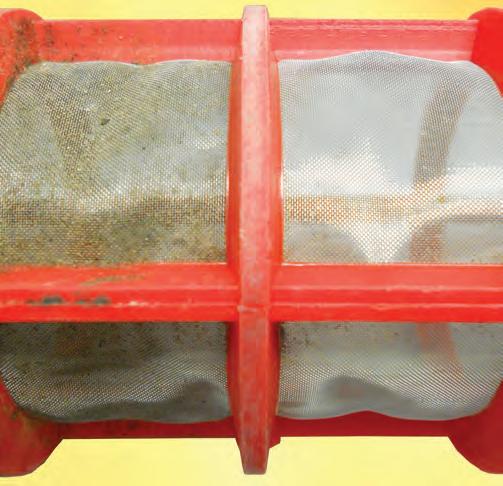
Although negative energy balance is a physiological adaption during transition and can have significant negative impact on reproduction of dairy cows, good nutrition in terms of adequate intake of energy and other essential nutrients such as B vitamins, can help to reduce the impact of negative energy balance.

These B vitamins play vital roles in various metabolic processes in improving energy status and reproductive performance.
It is essential that B vitamins are supplemented in the diet and in rumen protected form to be effective in dairy cows.
– Contributed by Jefo Australia
Figure one: Supplementation with rumenprotected B vitamins improved conception rate.
// 33 DAIRY NEWS AUSTRALIA JUNE 2023 CALF REARING Innovation. Quality. Solutions. ®Registered trademark of AgNova Technologies Pty Ltd. 220511 Suction filter washed with water. Suction filter cleaned with All Clear DS. with You’ll
significant impact on the reproductive performance of dairy cows.
stick with
When it comes to removing damaging residues from your boom sprayer, All Clear DS outperforms other tank cleaners on the widest range of products.
Because little else does!
To drench or not to drench?
BY DR GEMMA CHUCK
THIS MONTH we discuss how gastrointestinal worms can be managed through chemical control.
The term “drench” refers to a group of chemicals called anthelmintics which are anti-parasitic.
The term “drench” is actually quite inaccurate as it implies either thoroughly wetting the animal or giving something orally.
Traditionally, this could have referred to the method of administration for these products but anthelmintics have been available in injectable form for many years now and therefore the term seems a little out-dated.
Flukicides are a separate group of anti-parasitic and are specifically designed for the control of liver fluke.
The majority of anthelmintics registered for use in dairy cattle are considered broad-spectrum, meaning they are effective against a wide range of gastrointestinal worms and at different stages of their lifecycles.

There are three classes of anthelmintic available for use.

Benzimidazoles (the ‘white’ drenches)
First discovered in the 1960s, the white drenches were highly effective against adult and immature gastrointestinal worms. Unfortunately, their overuse has led to a
resistance of gastrointestinal worms on up to 50 per cent of properties in some countries.
The species of worms relevant to this problem in dairy cattle include Ostertagia
PROACTIVE BIOSECURITY PLANS TO MITIGATE THE RISK OF NEW DISEASES ENTERING YOUR HERD.
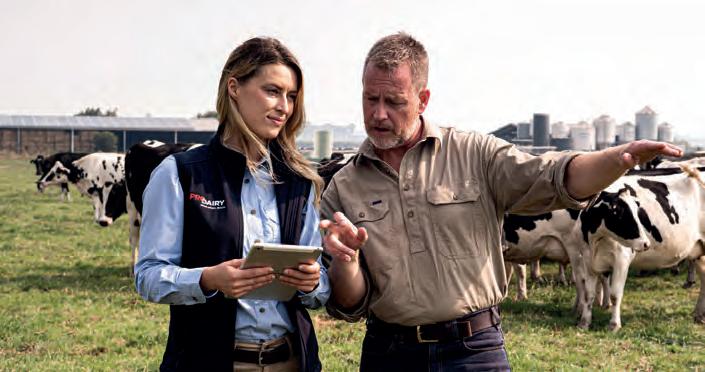
ProDairy can assist you with the development of a tailored plan:
• On-farm visit by a ProDairy veterinarian.
• Review of the current biosecurity principles, the major risks and actions taken to reduce those risks.
• Development of a customised biosecurity plan. Visit prodairy.com.au for more information.
spp., Cooperia spp., Haemonchus spp. and Trichostrongylus spp
They are generally administered orally and have little to no residual effect.
This means that a single treatment will kill the worms present in the animal at the time of treatment, but it will not protect the animal against re-infestations.
An example of a white drench registered for use in dairy cattle is fenbendazole (Panacur, Coopers Animal Health).
Levamisole (the ‘clear’ drenches)
Levamisole has been used for the control of gastrointestinal worms in dairy cattle for about five decades.
It is effective against mature worms and larval stages of some species, although is ineffective against the arrested stage of Ostergia ostertagii which limits its sole use in certain regions of Australia during at-risk periods.
Like the white drenches, resistance is common particularly from Ostertagia spp. but also Trichostrongylus spp
Levamisole is generally available as an oral drench or a pour-on. Pour-on products containing levamisole should be used with caution in hot weather as toxicity can develop due to rapid absorption.
Levamisole has minimal residual effect but is frequently used in combination drenches. Macrocyclic Lactones (the “MLs” or ‘mectin’ drenches)
In the 1980s the first macrocyclic lactone, ivermectin, was introduced and it revolutionised the control of veterinary parasites in livestock, horses and pets.
These chemicals are highly effective against a broad range of gastrointestinal worms but are also classed as endectocides, meaning they are effective against ectoparasites as well (lice, mites, ticks).
However, they are ineffective against flukes (trematodes) or tapeworms (cestodes).
Unfortunately, resistance of gastrointestinal worms to the macrocyclic lactones has been found in many species, including cattle.
In Australia, the worm species that have shown resistance include Cooperia spp, Ostertagia spp, Trichostrongylus spp and Haemonchus spp.
The ‘mectin drenches’ can be administered orally, by injection or as a pour-on.
They have a much longer residual activity than the other classes of anthelmintic, meaning they offer a period of protection after a single treatment.
This is due to them being stored in the body fat after administration and then released back into the blood over several weeks or months.
Examples of macrocyclic lactones registered for use in dairy cattle include doramectin (Dectomax, Zoetis), moxidectin (Cydectin, Virbac) and eprinomectin (Ivomec Eprinex®, Merial).
Combination drenches
More recently, the macrocyclic lactones have been used in combination drenches with the benzimidazoles and/or levamisole.
Research has shown that using effective combinations of two or more classes of anthelmintic at the same time helps prevent and slow the development of resistance.
By the concurrent administration of multiple anthelmintics, gastrointestinal parasites that have shown resistance to one of the classes of anthelmintic can still be targeted.
The best time to use a combination drench is before resistance has developed and while the effectiveness of the individual active ingredients is still high.
Combination drenches registered for use in dairy cattle include Eclipse (Merial), Trifecta (Coopers Animal Health), Cydectin Platinum (Virbac) and Dectomax V (Zoetis).
Ensure your choice of anthelmintic is registered for use in dairy cattle and observe when and how the product should be administered and what the withholding period is.
Some products are registered for use in dairy heifers and dry cows, but not for lactating animals.

It is important to note that gastrointestinal parasites have shown resistance to all classes of anthelmintic on a global scale.
While the use of combination drenches will help slow this process, we need to look at alternative methods to prevent the unnecessary use of drenches.
This article has been adapted from an original by Dr Gemma Chuck published in DNA, October 2017.
34 // DAIRY NEWS AUSTRALIA JUNE 2023 ANIMAL HEALTH
YOU COVERED.
PRODAIRY.COM.AU SCAN TO FIND OUT MORE.
The majority of anthelmintics registered for use in dairy cattle are considered broad-spectrum, meaning they are effective against a wide range of gastrointestinal worms and at different stages of their lifecycles.
PRODAIRY. WE’VE GOT
Designed for Dairy Farmers. Delivered by Dairy Vets.
Popular sprayers showcased
THIS YEAR’S Silvan autumn catalogue features a range of popular sprayers. A selection are featured below.
40 litre Silvan spot sprayer
This compact 40 litre spot sprayer has been designed to be an affordable solution for applying pesticides, agricultural and horticultural herbicides for weeds and insecticides to plants.
Included is a chemical resistant diaphragm pump which produces an open flow of 2.6 litres/minute with a maximum pressure of 50psi.
Other features include 3m of wiring loom with alligator clips, inline on/off switch and fuse.
The sprayer consists of a translucent poly tank for viewing the content level and comes with a trigger jet spray with 450mm lance and adjustable spray nozzle, which delivers a coarse pencil straight stream through to a fine mist.
Attached to the nozzle is a 6m x 8mm long agricultural hose.

400 litre Redlink linkage sprayer
This sprayer with 400 litre Polytuff tank is ideally suited to dairy, livestock and lifestyle farmers.
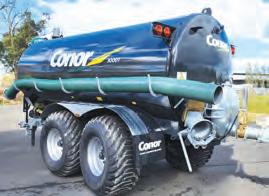
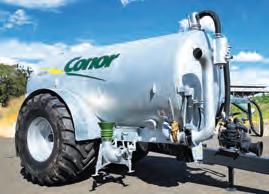

It features a self-priming BP60/20 pump with a pressure capacity of 2000k/Pa to dispense 58 litre/minute, a hose reel and gun and 6m long Econopak boom.

Another feature is a three-outlet manual control valve with pressure regulator mounted forward for easy access.
The boom comes with stainless steel spray lines, non-drip nozzle holders, a fully galvanised frame and is spring loaded for safely moving back and forward.
Air induction nozzles with strainer in bayonet fit non-drip nozzle holders at 50cm spacings.
The 30m x 10mm rear mounted Eco hose reel comes with a Spotjet spray gun with adjustable nozzle.
Options include a 14 litre single or 16 litre double side foam marker.


25 litre rechargeable trolley sprayer
The Silvan 25 litre heavy duty, fully portable, trolley sprayer is easy to move around the garden or property and ideal for applying herbicides, insecticides and fertilisers.
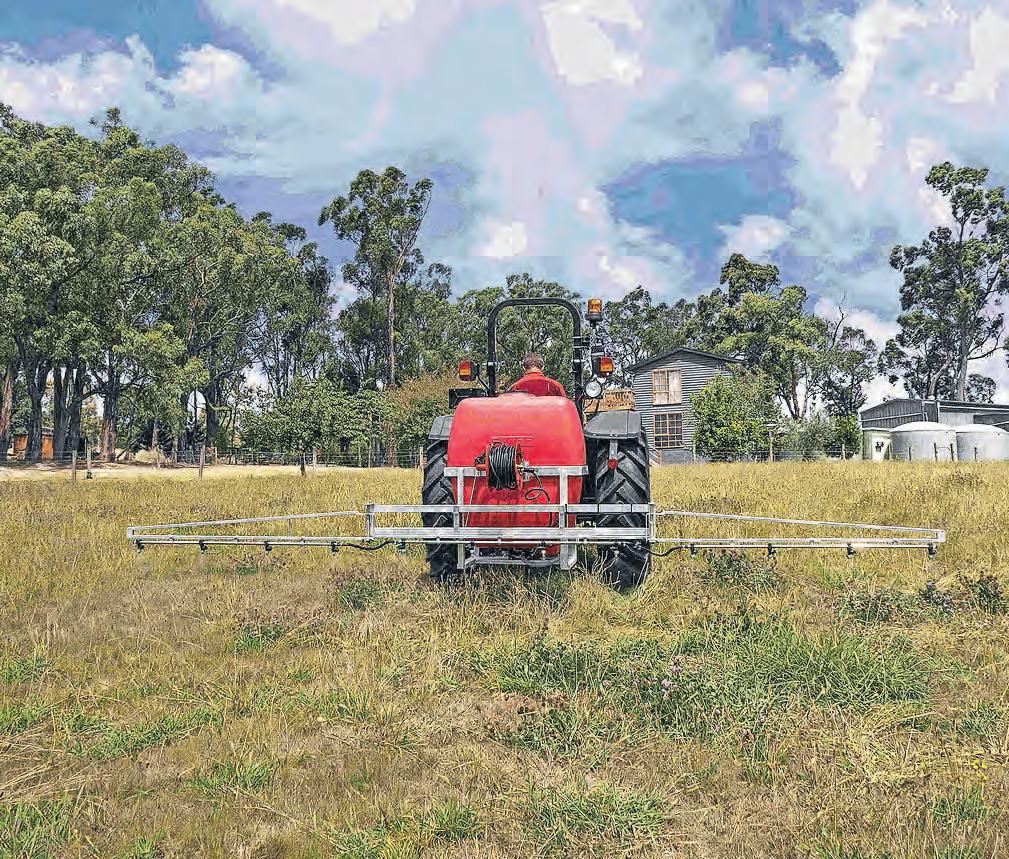
It delivers up to 1.25 litres/minute open flow or maximum of three bar/45psi.
The sprayer has been upgraded with the addition of a S-power lithium-ion rechargeable battery system, which allows for three tanks of spraying per charge.
The unit provides up to 1.5 hours operation from one full charge.
The battery, which contains a life indicator with on/off switch, also fits the 12 litre Rechargeable Backpack Sprayer (WP12-1).
Other features include a 6m delivery hose with storage hanging hook, spray gun holder, large 265mm Ezy Glide wheels, an angled handle making it easy to move around, weighted stainless steel strainer for maximum delivery and a 25mm drain bung for fast easy cleaning.
The unit also has a large adjustable loop handle and wide wheel base for maximum stability and easy carting.
The trigger jet spray gun comes with a 550mm long stainless steel lance and adjustable
nozzle that allows for a straight pencil stream to a fine conical mist. A convenient lance holder and clip allows for neat and easy storage.
Continued on page 36
Redlink sprayers are suited to dairy, livestock and lifestyle farmers.
// 35 DAIRY NEWS AUSTRALIA JUNE 2023 MACHINERY & PRODUCTS IN STOCK & READY FOR IMMEDIATE DELIVERY!
Continued from page 35
300 litre Lightfoot trailed sprayer with reel and folding boom
This sprayer is equipped with a 12 volt pump, with pressure regulator, which delivers up to 20 litre/minute at a maximum pressure or 4 bar/ 60psi.
The LT30-S8-2 model has a 30m hose reel and atomiser spray gun and 4m cross fold boom for more precise application and the LT30-S8-1 has a 6m hose and Spotjet adjustable spray gun and 7.6m boom-less nozzle.
These complete trailed ATV sprayers come pre-equipped ready for spot and boom spraying to suit a variety of applications.
100 litre Utepak Trukpak sprayer

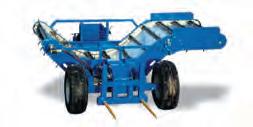

A professional self-contained sprayer favoured for its flexible range of options and industrial design.
It can be fitted to a utility, carryall or UTV for a range of applications including pest control, road side spraying or on-farm.
The sprayer comes with a 12V Smoothflo 12V pump 7 litre/min (open flow) or max 8 Bar/120psi for pulsation free spraying.
Other features include a 15m x 9.5mm retractable spring loaded hose reel with swivelling body, which adds 445mm of height, and Spotjet spray gun.
15 metre spring retractable hose reel

The 15m by 10mm spring retractable hose and reel is suitable for air, water or agricultural chemicals.
It is ideal for linkage, 100 litre Redline and Smoothflo sprayers.

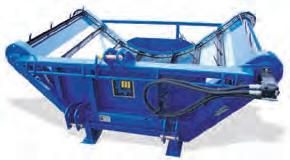


Transporters slam
BY GEOFF ADAMS
A TAX on the transport industry, increased in the federal budget, is likely to push freight charges up and may lead to more expensive food and grocery items.
The transport industry is warning that the increased costs from a road user charge are likely to be passed on to consumers and that some smaller regional operators may be forced out of business.
Kreskas Brothers Transport general manager Adam Katsoutas said the concept of easing inflation and reducing the cost of living crisis was at the forefront of everyone’s mind, though an increase of six per cent compounding over the next three years would eventually end up affecting families across the region.
“A quarter of Victoria’s heavy vehicles are registered in this region,” he said.
While bigger companies may be able to negotiate passing the costs on, smaller operators may not have this option, he said.
Mr Katsoutas believes the extra charges could impact on food and grocery prices.
“I would find it hard to comprehend if a transport company is able to absorb this additional increase, as well, after what has occurred over the last two years,” he said.
“Anecdotally I am hearing some growers working with major retailers won’t be able to pass this cost on and will need to absorb it, though for the majority it would have to be passed on, meaning local families visiting the checkouts will be paying more for their groceries.”
It can also be mounted on a workshop wall. The 15m x 10mm hose is capable of delivering 20 bar/290psi of pressure.
For further information, phone 1300 745 826, email info@silvanaust.com.au or visit: www.silvan.com.au
“It doesn’t matter if they’re carting fresh produce such as fruit, vegetables, fresh milk, livestock, grain or even manufactured goods, this heavy vehicle road charge will sooner or later be needed to be passed on to the grower, farmer, or manufacturer, which then they will have no choice but to pass it on where it eventually trickles down to local checkouts.”
Federal Member for Nicholls Sam Birrell, which covers northern Victoria, said the increase would add to inflationary pressures and could pose a threat to the transport industry, which was integral to the northern Victorian economy.
Asked if the charges were a compensation for the impact of heavy vehicles, Mr Katsoutas said the transport industry had done an amazing job over the past decade continually improving safety and equipment, with significant private investment from local operators coming in the way of upkeep of road-friendly suspension, PBS (performance-based standards) approved trailers that were closely scrutinised by engineers, and strict National Heavy Vehicle Regulator compliance measures.
“I believe the majority of the industry is co-operating playing our part in minimising the impact to our roadways,” he said.
“Though I also understand the comments that heavy vehicles operating at weights may cause a majority of wear and tear though,the burden can’t be worn by one industry alone.
LABOUR SAVING
McIntosh Multi Bale Feeders
 A 400 litre Redlink linkage sprayer.
A 400 litre Redlink linkage sprayer.
36 // DAIRY NEWS AUSTRALIA JUNE 2023 MACHINERY & PRODUCTS To find your nearest dealer, please contact: www.tracmac.com.au 03 5625 1522 IF YOU ARE A LARGE HERD OWNER AND DO MULTIPAL TRIPS FEEDING YOUR HERDS, THEN THE McINTOSH MULTI 4 OR MULTI 5 BALE FEEDER IS THE MACHINE FOR YOU. These award winning bale feeders have been carefully designed to handle all types of Round bale silage and hay, without fuss. With its bale capacity, clever design and rugged construction, that makes the Multi bale feeder simple and easy to operate.
15 metre spring retractable hose and reel.
slam road tax increase
“I would suggest looking at a user pays approach, spreading the load against all registrations.”















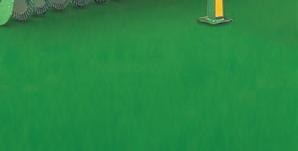
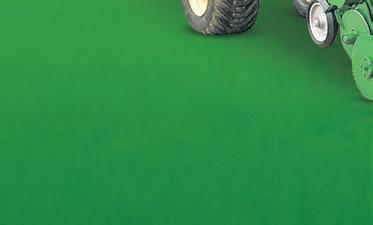



































The National Road Transport Association is bitterly disappointed with the decision to increase the road user charge for heavy vehicles by six per cent over each of the next three years.
NatRoad chief executive Warren Clark said the increase was unconscionable and would
sound the death knell for some operators, many of them reportedly running on a profit margin of just 2.5 per cent.





“This is a cruel blow to operators already under extreme stress who are desperately trying to stay viable,” Mr Clark said.

Mr Clark said the RUC would increase from 27.2¢ a litre to 28.8¢ in 2023-24, jumping to 30.5¢ and 32.4¢ in the years after.
Registration costs for a six-axle articulated
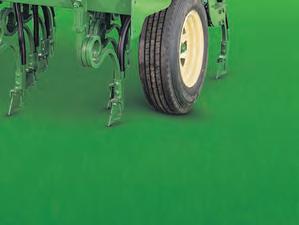



truck will go from the current $6530 (2022-23) to $6872 (2023-24), and then to $7236 and $7621.
NatRoads chairman Paul Fellows, who runs a small transport business in Deniliquin, said while some bigger firms might be able to pass on the increased costs, smaller companies would not be in a position to negotiate.




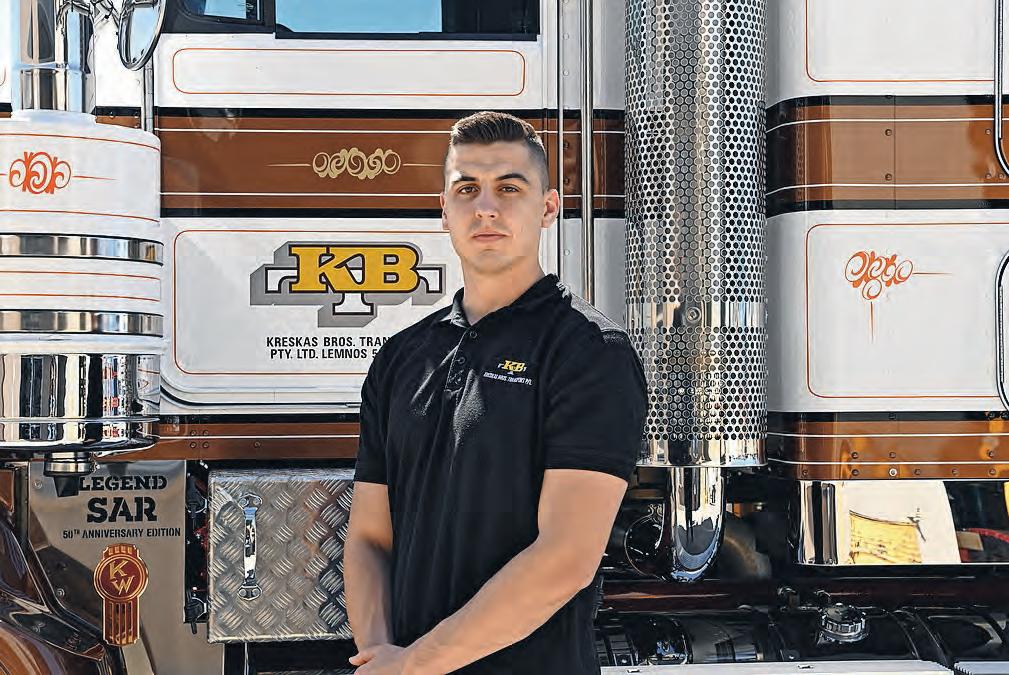
Mr Fellows said some older company operators with small businesses were making the decision to exit the industry, leaving fewer
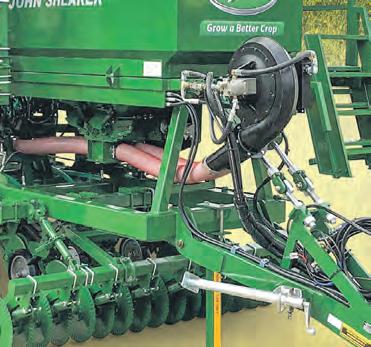

companies and less competition.
“These smaller operators are the lifeblood of regional communities,” Mr Fellows said. He was also concerned with the lack of transparency over the charges, as the original intent of the charges was to compensate for the impact of heavy vehicles on roads, however the money raised by the tax does not get apportioned to road funding but goes into consolidated revenue.
Transporters
Kreskas Brothers Transport general manager Adam Katsoutas.
// 37 DAIRY NEWS AUSTRALIA JUNE 2023 MACHINERY & PRODUCTS
NatRoads chairman Paul Fellows.
Vintage tractor joins collection




ONE OF the earliest surviving tractors manufactured in Australia has been acquired by the National Museum of Australia in Canberra.
The significant transformation of Australia’s agricultural industry is represented by the extraordinary McDonald ‘Imperial’ oil ‘EB’ tractor, which went on display in the museum’s Gandel Atrium in mid-May.

The tractor, built in 1912, substantially adds to the Museum’s National Historical Collection and supports it’s mission to tell remarkable stories from Australian history.
It was acquired by the National Museum for $250,000, with the support of the Federal Government through the National Cultural Heritage Account, a grant program that assists
Australian cultural organisations to acquire significant cultural heritage objects.




The McDonald ‘EB’ oil tractor is one of three complete examples manufactured in Australia by AH McDonald & Co of Richmond, Melbourne.
In 1908, innovative Melbourne engineers Alfred and Ernest McDonald produced the first Australian-made, oil-powered tractor, known as the ‘EA’. The improved design of the ‘EB’ followed in 1912.
It provides a revealing insight into the global transformation in automotive and agricultural practices triggered by the invention of the oil-driven, internal combustion engine in the 1870s.
National Museum director Mathew Trinca thanked the Federal Government for its
financial assistance with the purchase of the tractor, which he said was an unrivalled example of Australian ingenuity and design.

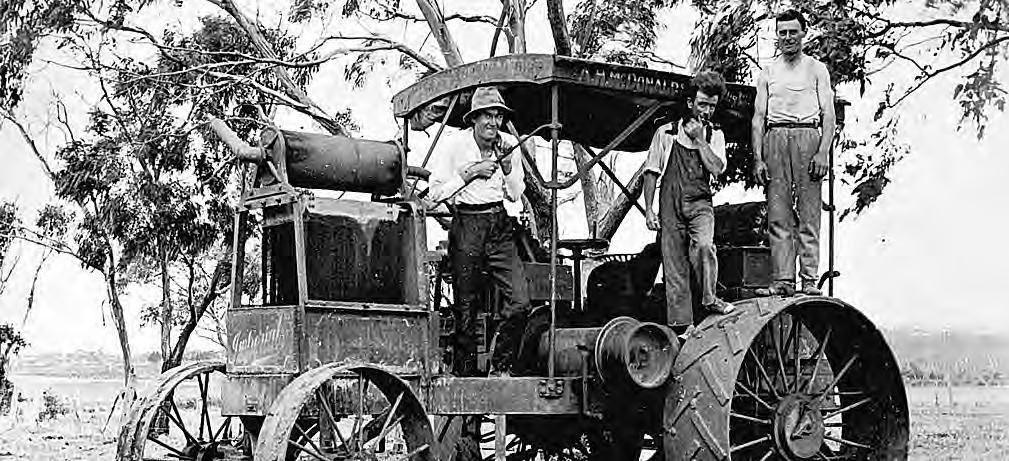
“The McDonald ‘EB’ oil tractor represents a theme of Australian innovation in a revolutionary era for engineering. This acquisition represents our agricultural history, and we are thrilled to share it with Australia,” Dr Trinca said.
The tractor was originally purchased new in 1912 by Frank William Chilcott for use at Lillesdon Park, his 163ha farm located on French Island in Victoria’s Western Port Bay.
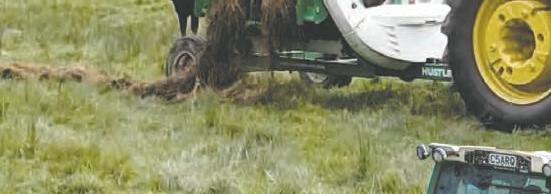


It was likely used for land clearing as part of the local chicory cultivation industry, which was a prolific industry on French Island until the mid-1960s.


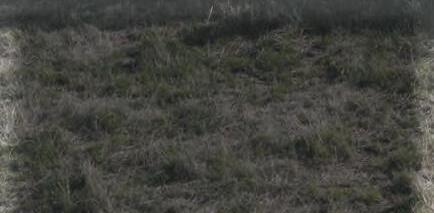




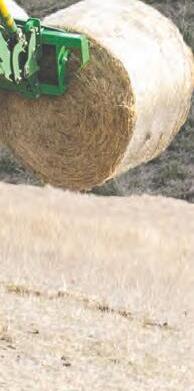
Museum curator Ian Coates, who coordinated the acquisition of the tractor, said it had historic significance because of its association with Australia’s first tractor manufacturer.
“Perhaps the most remarkable aspect of the early tractors produced by AH McDonald & Co was the relative sophistication of their engineering, which included coil ignition, a three-speed gearbox and automotive rack-andpinion steering,” Dr Coates said.
“This reflects Alf McDonald’s capacity to improve the contemporary design of imported American tractors.”








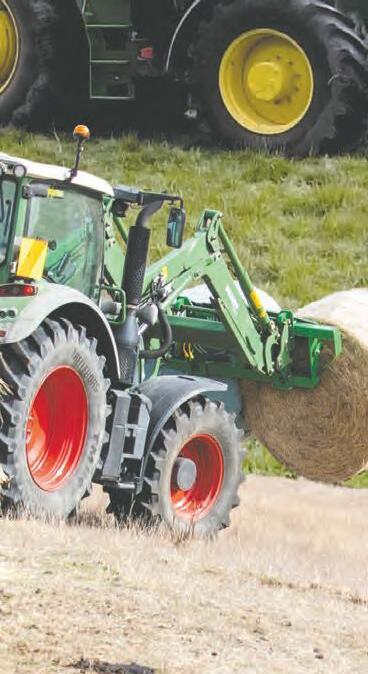


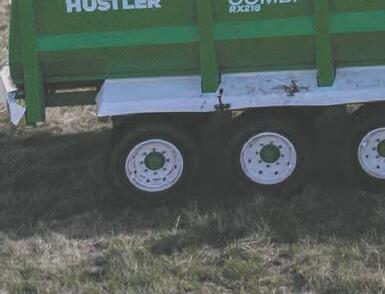
It was acquired with the support of an anonymous benefactor.
The tractor will be on display at the National Museum of Australia until July 23.
The 1912 McDonald ‘EB’ Imperial tractor no. 140 on display in the Gandel Atrium.
Photo: National Museum of Australia/Jason McCarthy
Three men, possibly Bennetts family members, with the ‘EB’ tractor at French Island, 1926.
38 // DAIRY NEWS AUSTRALIA JUNE 2023 MACHINERY & PRODUCTS CHAINLESS BALE FEEDERS MOUNTED OR TRAILED • Feed out any shape bale –rounds or squares • Teases hay apart • Sturdy & simple – less maintenance for more information visit hustlerequipment.com | 1800 750 428 or 0427 334 821 IT’S FEEDIN’
CHAIN BALE UNROLLERS A NEW FAMILIAR FRIEND • 12,000 lb roller chains • Feeds out either side • Auto-connection system make operation quicker & simpler • NEW compact size even easier to • operate in tight situations COMBI RX FEEDOUT WAGONS THE BIGGEST INNOVATION OF FEEDOUT WAGONS EVER. • Chainless rear floor for reliability • Stepless 2.55 m wide main bin • Impact-resistant floors • Easy fingertip FeedControl
Photo: Museums Victoria/G Bennetts
TIME!




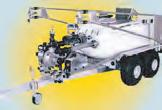




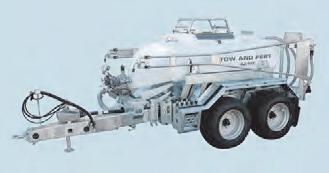
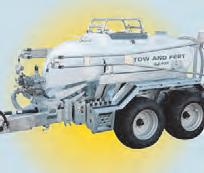




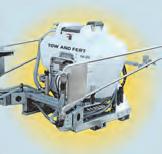





Available in 5 models. Tow and Fert. There is one for your farm. A Tow and Fert is a SMART BUSINESS INVESTMENT Image shows spraying with a Tow and Fert Multi 4000 on Josh Stephens farm in Camperdown, Victoria www.towandfert.com.au Multi 500 Multi 1000 Multi 1200 Multi 2800 Multi 4000 We have been able to reduce our synthetic N to almost nothing and we are not tied into a high input system. With the cost of urea now, it’s a really good cost to avoid. Owen Billing, Dairy Farmer Tow and Fert Multi 1200 Owner “ “ I think getting a Tow and Fert was probably the game changer in our farm business and contracting. I think the Tow and Fert and foliar spray is the way of the future. Josh Stephens, Dairy Farmer/Contractor Tow and Fert Multi4000 Owner “ “ Reduce ‘N’, Apply Capital Fert, small seeds & more, all from one tank. Image shows spraying with a Tow and Fert Multi 1200 onOwen Billings farm in Gippsland, Victoria





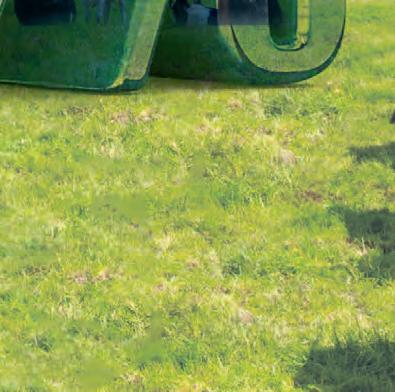







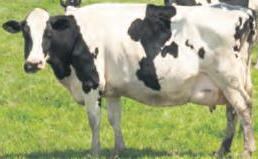







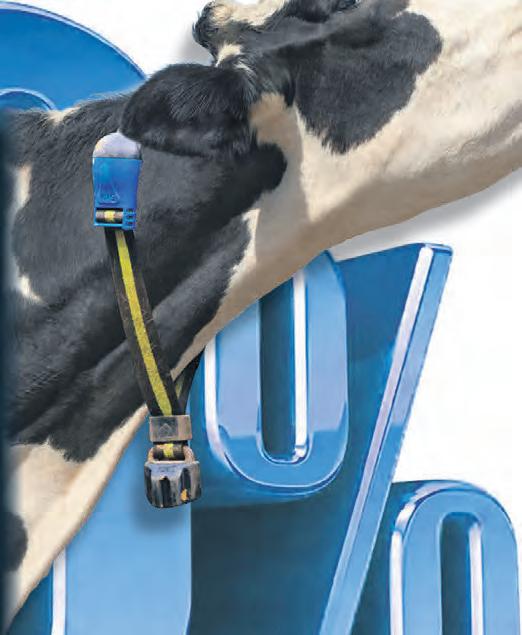
www.allflex.com.au 1300 138 247 * Receive 20% off monitoring collarsand related application plans when you ordera new Allflex Monitoring System before June 30th 2023. Standard pricing applies for all other Allflex monitoring system components. ^ The Allflex® Extended Payment Plan is onlyavailable where a new Allflex® Livestock Monitoring system, which includes neck or tag monitoring devices, application plansand system software licenses, is purchased and installed on a dairy farm inAustralia. To open a new account and have access to an Extended Payment Plan, customers must apply for, and be approved to opena directaccount with Intervet Australia Pty Ltd. Credit checks will be conducted. ® Registered trademarks. Copyright © 2023 Merck & Co., Inc., Rahway, NJ, USA and its affiliates. Allrights reserved. EOFY DISCOUNT Before 30th June 2023, you can get 20% OFF ALLFLEX® SENSEHUB® DAIRY MONITORING COLLARS AND APPLICATION PLANS * when you purchase a new Allflex monitoring system to help improve heat detection accuracy, identify non-cycling cows, improve herd health and much, much more. Plus, you can also get 24 months interest free.^ YOU KNOW IT MAKES SENSE















 BY ISABEL DANDO
BY ISABEL DANDO
































































































































































 A new line being promoted by Bega with Vegemite.
A new line being promoted by Bega with Vegemite.


















 Henry Bevan, with he and his wife’s two children, says he has come to rely on the CowManager system entirely for heat detection.
Henry Bevan, with he and his wife’s two children, says he has come to rely on the CowManager system entirely for heat detection.

























































































































































 Bulla Dairy Foods has kicked off the milk pricing competition, with price bands set between $8.80 and $9.60/kg milk solids.
Bulla Dairy Foods has kicked off the milk pricing competition, with price bands set between $8.80 and $9.60/kg milk solids.











































































































 A 400 litre Redlink linkage sprayer.
A 400 litre Redlink linkage sprayer.
















































































































